The Bronx

The Bronx

The Bronx Bronx County, New York | |
|---|---|
Borough and county | |
 Yankee Stadium (center), Bronx County Courthouse and the Grand Concourse towards the top. To the right of the current stadium is the site of its predecessor. | |
| Motto(s): Ne cede malis – "Yield Not To Evil" (lit. "Yield Not to Evil Things") | |
 Map outlining the Bronx | |
 Location within the state of New York | |
| Coordinates:40°50′14″N 73°53′10″W [239] | |
| Country | United States |
| State | New York |
| County | Bronx (coterminous) |
| City | New York City |
| Borough created | 1898 (County in 1914) |
| Named for | Jonas Bronck |
| Government | |
| • Type | Borough of New York City |
| • Borough President | Rubén Díaz Jr. (D) – (Borough of the Bronx) |
| • District Attorney | Darcel Clark – (Bronx County) |
| Area | |
| • Total | 57 sq mi (150 km2) |
| • Land | 42 sq mi (110 km2) |
| • Water | 15 sq mi (40 km2) 27% |
| Highest elevation | 280 ft (90 m) |
| Population (2017) | |
| • Total | 1,471,160[3] |
| • Density | 35,027.6/sq mi (13,524.2/km2) |
| Time zone | UTC−05:00 (Eastern) |
| • Summer (DST) | UTC−04:00 (EDT) |
| ZIP Code prefix | 104 |
| Area codes | 718/347/929, 917 |
| GDP (2015) | US$29 billion[4] |
| Website | bronxboropres.nyc.gov [240] |
The Bronx is a borough of New York City, coterminous with Bronx County, in the U.S. state of New York, the third-most densely populated county in the United States.[5] It is south of Westchester County; northeast and east of Manhattan, across the Harlem River; and north of Queens, across the East River.
The Bronx has a land area of 42 square miles (109 km2) and a population of 1,471,160 in 2017.[3] Of the five boroughs, it has the fourth-largest area, fourth-highest population, and third-highest population density.[5] It is the only borough predominantly on the U.S. mainland.
The Bronx is divided by the Bronx River into a hillier section in the west, and a flatter eastern section. East and west street names are divided by Jerome Avenue. The West Bronx was annexed to New York City in 1874, and the areas east of the Bronx River in 1895.[6] Bronx County was separated from New York County in 1914.[7] About a quarter of the Bronx's area is open space,[8] including Woodlawn Cemetery, Van Cortlandt Park, Pelham Bay Park, the New York Botanical Garden, and the Bronx Zoo in the borough's north and center. These open spaces are situated primarily on land deliberately reserved in the late 19th century as urban development progressed north and east from Manhattan.
The name Bronx originated with Swedish-born Jonas Bronck, who established the first settlement in the area as part of the New Netherland colony in 1639.[9][10][11] The native Lenape were displaced after 1643 by settlers. In the 19th and 20th centuries, the Bronx received many immigrant and migrant groups as it was transformed into an urban community, first from various European countries (particularly Ireland, Germany, Italy and Eastern Europe) and later from the Caribbean region (particularly Puerto Rico, Haiti, Jamaica, and the Dominican Republic), as well as African American migrants from the southern United States.[12] This cultural mix has made The Bronx a wellspring of Latin music, hip hop and rock.
The Bronx contains the poorest congressional district in the United States, the 15th. There are, however, some upper-income, and middle-income neighborhoods such as Riverdale, Fieldston, Spuyten Duyvil, Schuylerville, Pelham Bay, Pelham Gardens, Morris Park, and Country Club.[13][14][15] The Bronx saw a sharp decline in population, livable housing, and quality of life in the late 1960s, 1970s, and 1980s culminating in a wave of arson. In addition, the South Bronx saw severe urban decay. The Bronx experienced some redevelopment starting in the 1990s.[16]
New York City's five boroughs | ||||||||
|---|---|---|---|---|---|---|---|---|
| Jurisdiction | Population | Gross Domestic Product | Land area | Density | ||||
| Borough | County | Estimate (2017)[17] | billions (US$)[18] | per capita (US$) | square miles | square km | persons / sq. mi | persons / sq. km |
The Bronx | Bronx | 1,471,160 | 28.787 | 19,570 | 42.10 | 109.04 | 34,653 | 13,231 |
Brooklyn | Kings | 2,648,771 | 63.303 | 23,900 | 70.82 | 183.42 | 37,137 | 14,649 |
New York | 1,664,727 | 629.682 | 378,250 | 22.83 | 59.13 | 72,033 | 27,826 | |
Queens**** | 2,358,582 | 73.842 | 31,310 | 108.53 | 281.09 | 21,460 | 8,354 | |
Richmond | 479,458 | 11.249 | 23,460 | 58.37 | 151.18 | 8,112 | 3,132 | |
City of New York | 8,622,698 | 806.863 | 93,574 | 302.64 | 783.83 | 28,188 | 10,947 | |
State of New York | 19,849,399 | 1,547.116 | 78,354 | 47,214 | 122,284 | 416.4 | 159 | |
Sources:[19] and see individual borough articles | ||||||||
The Bronx Bronx County, New York | |
|---|---|
Borough and county | |
 Yankee Stadium (center), Bronx County Courthouse and the Grand Concourse towards the top. To the right of the current stadium is the site of its predecessor. | |
| Motto(s): Ne cede malis – "Yield Not To Evil" (lit. "Yield Not to Evil Things") | |
 Map outlining the Bronx | |
 Location within the state of New York | |
| Coordinates:40°50′14″N 73°53′10″W [239] | |
| Country | United States |
| State | New York |
| County | Bronx (coterminous) |
| City | New York City |
| Borough created | 1898 (County in 1914) |
| Named for | Jonas Bronck |
| Government | |
| • Type | Borough of New York City |
| • Borough President | Rubén Díaz Jr. (D) – (Borough of the Bronx) |
| • District Attorney | Darcel Clark – (Bronx County) |
| Area | |
| • Total | 57 sq mi (150 km2) |
| • Land | 42 sq mi (110 km2) |
| • Water | 15 sq mi (40 km2) 27% |
| Highest elevation | 280 ft (90 m) |
| Population (2017) | |
| • Total | 1,471,160[3] |
| • Density | 35,027.6/sq mi (13,524.2/km2) |
| Time zone | UTC−05:00 (Eastern) |
| • Summer (DST) | UTC−04:00 (EDT) |
| ZIP Code prefix | 104 |
| Area codes | 718/347/929, 917 |
| GDP (2015) | US$29 billion[4] |
| Website | bronxboropres.nyc.gov [240] |
Etymology and naming
Early names
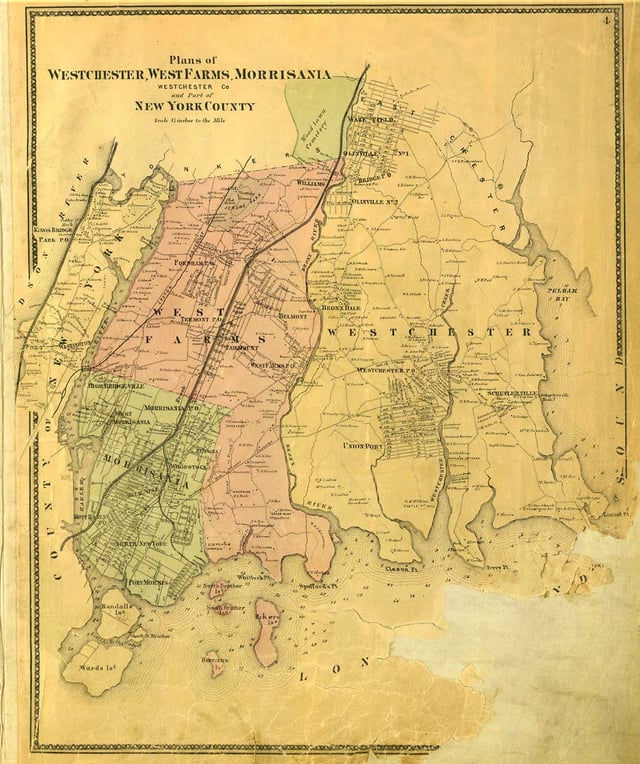
Map of the Bronx in 1867
The Bronx was called Rananchqua[20] by the native Siwanoy[21] band of Lenape (also known historically as the Delawares), while other Native Americans knew the Bronx as Keskeskeck.[22] It was divided by the Aquahung River.
The origin of the person of Jonas Bronck (c. 1600–43) has been contested. Documents indicate that he was a Swedish-born emigrant from Komstad, Norra Ljunga parish in Småland, Sweden, who arrived in New Netherland during the spring of 1639.[11][23][24][25][26][27] Bronck became the first recorded European settler in the area now known as The Bronx and built a farm named "Emmaus" close to what today is the corner of Willis Avenue and 132nd Street in Mott Haven.[28] He leased land from the Dutch West India Company on the neck of the mainland immediately north of the Dutch settlement of New Haarlem (on Manhattan Island), and bought additional tracts from the local tribes. He eventually accumulated 500 acres (200 ha) between the Harlem River and the Aquahung, which became known as Bronck's River or the Bronx [River]. Dutch and English settlers referred to the area as Bronck's Land.[23] The American poet William Bronk was a descendant of Pieter Bronck, either Jonas Bronck's son or his younger brother, but most probably a nephew or cousin, as there was an age difference of 16 years.[29] Much work on the Swedish claim has been undertaken by Brian G. Andersson, former Commissioner of NYC's Dept. of Records, who assisted in organizing a 375th Anniversary celebration in Bronck's hometown in 2014. [30]
Use of definite article
The Bronx is referred to with the definite article as "The Bronx", both legally[31] and colloquially.[32] The County of Bronx does not place "The" immediately before "Bronx" in formal references, unlike the coextensive Borough of the Bronx, nor does the United States Postal Service in its database of Bronx addresses (the city and state mailing-address format is simply "Bronx, NY").[33] The region was apparently named after the Bronx River and first appeared in the "Annexed District of The Bronx" created in 1874 out of part of Westchester County. It was continued in the "Borough of The Bronx", which included a larger annexation from Westchester County in 1898. The use of the definite article is attributed to the style of referring to rivers.[34][35] A time-worn story explanation for the use of the definite article in the borough's name stems from the phrase "visiting the Broncks", referring to the settler's family.[36]
The capitalization of the borough's name is sometimes disputed. Generally, the definite article is lowercase in place names ("the Bronx") except in official references. The definite article is capitalized ("The Bronx") at the beginning of a sentence or in any other situation when a normally lowercase word would be capitalized.[37] However, some people and groups refer to the borough with a capital letter at all times, such as Lloyd Ultan, a historian for The Bronx County Historical Society, and the Great and Glorious Grand Army of The Bronx, a Bronx-based organization. These people say that the definite article is part of the proper name.[38][39] In particular, the Great and Glorious Grand Army of The Bronx is leading efforts to make the city refer to the borough with an uppercase definite article in all uses, comparing the lowercase article in the Bronx's name to "not capitalizing the 's' in 'Staten Island.'"[39]
History
European colonization of the Bronx began in 1639. The Bronx was originally part of Westchester County, but it was ceded to New York County in two major parts (West Bronx, 1874 and East Bronx, 1895) before it became Bronx County. Originally, the area was part of the Lenape's Lenapehoking territory inhabited by Siwanoy of the Wappinger Confederacy. Over time, European colonists converted the borough into farmlands.
The development of the Bronx is directly connected to its strategic location between New England and New York (Manhattan). Control over the bridges across the Harlem River plagued the period of British colonial rule. The King's Bridge, built in 1693 where Broadway reached the Spuyten Duyvil Creek, was a possession of Frederick Philipse, lord of Philipse Manor.[40] The tolls were resented by local farmers on both sides of the creek, and in 1759, Jacobus Dyckman and Benjamin Palmer led them in building a free bridge across the Harlem River.[41] After the American Revolutionary War, the King's Bridge toll was abolished.[42][40]
The territory now contained within Bronx County was originally part of Westchester County, one of the 12 original counties of the English Province of New York. The present Bronx County was contained in the town of Westchester and parts of the towns in Yonkers, Eastchester, and Pelham. In 1846, a new town was created by division of Westchester, called West Farms. The town of Morrisania was created, in turn, from West Farms in 1855. In 1873, the town of Kingsbridge was established within the former borders of Yonkers, roughly corresponding to the modern Bronx neighborhoods of Kingsbridge, Riverdale, and Woodlawn.
Among famous settlers in the Bronx during the 19th and early 20th centuries were author Willa Cather, tobacco merchant Pierre Lorillard, and inventor Jordan L. Mott, who established Mott Haven to house the workers at his iron works.[43]
The whole territory east of the Bronx River was annexed to the city in 1895, three years before New York's consolidation with Brooklyn, Queens, and Staten Island. This included the Town of Westchester (which had voted against consolidation in 1894) and portions of Eastchester and Pelham.[6][44][46][47][48] The nautical community of City Island voted to join the city in 1896.
On January 1, 1898, the consolidated City of New York was born, including the Bronx as one of the five distinct boroughs (at the same time, the Bronx's territory moved from Westchester County into New York County, which already contained Manhattan and the rest of pre-1874 New York City).
On April 19, 1912, those parts of New York County which had been annexed from Westchester County in the past decades were newly constituted as Bronx County, the 62nd and last county to be created by the state, effective in 1914.[44][49] Bronx County's courts opened for business on January 2, 1914 (the same day that John P. Mitchel started work as Mayor of New York City).[7] Marble Hill, Manhattan was now connected to the Bronx, but it did not become part of that county by a historical accident due to changes in waterways.
After 1914
The history of the Bronx during the 20th century may be divided into four periods: a boom period during 1900–29, with a population growth by a factor of six from 200,000 in 1900 to 1.3 million in 1930. The Great Depression and post World War II years saw a slowing of growth leading into an eventual decline. The mid to late century were hard times, as the Bronx declined 1950–85 from a predominantly moderate-income to a predominantly lower-income area with high rates of violent crime and poverty. The Bronx has experienced an economic and developmental resurgence starting in the late 1980s that continues into today.[50]
New York City expands
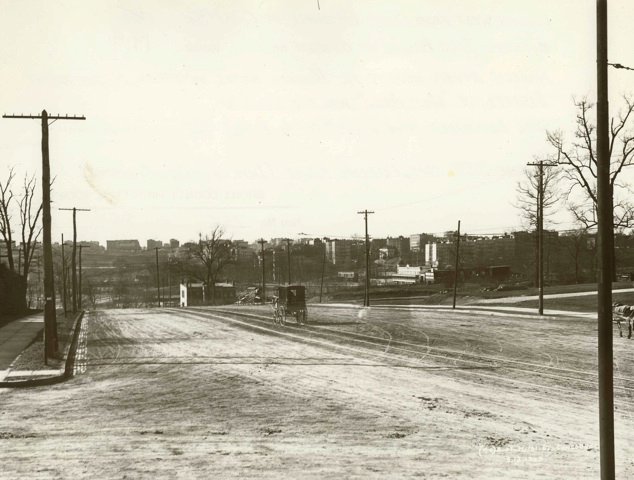
Grand Concourse and 161st Street as it appeared around 1900
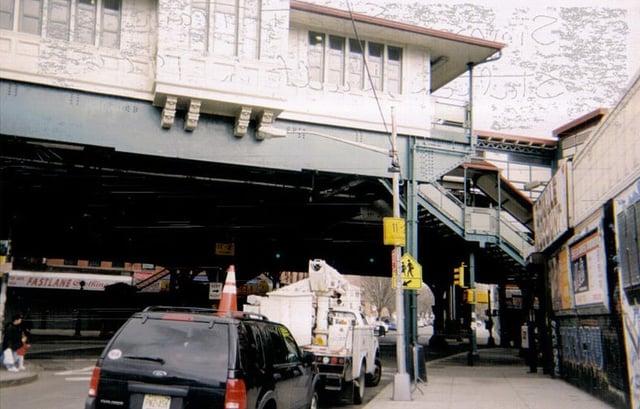
The Simpson Street elevated station was built in 1904 and opened on November 26, 1904. It was listed in the National Register of Historic Places on September 17, 2004, reference #04001027.
The Bronx was a mostly rural area for many generations, small farms supplying the city markets, but it grew into a railroad suburb in the late 19th century. Faster transportation enabled rapid population growth in the late 19th century, involving the move from horse-drawn street cars to elevated railways and the subway system, which linked to Manhattan in 1904.[50]
At the end of World War I, the Bronx hosted the rather small 1918 World's Fair at 177th Street and DeVoe Avenue.[6][52]
The Bronx underwent rapid urban growth after World War I. Extensions of the New York City Subway contributed to the increase in population as thousands of immigrants came to the Bronx, resulting in a major boom in residential construction. Among these groups, many Irish Americans, Italian Americans, and especially Jewish Americans settled here. In addition, French, German, Polish, and other immigrants moved into the borough. The Jewish population also increased notably during this time. In 1937, 592,185 Jews lived in The Bronx (43.9% of the borough's population),[53] while only 54,000 Jews lived in the borough in 2011. Many synagogues still stand in the Bronx, but most have been converted to other uses.[54]
Decline
Bootleggers and gangs were active in the Bronx during Prohibition (1920–33). Irish, Italian, Jewish, and Polish gangs smuggled in most of the illegal whiskey, and the oldest sections of the borough became poverty-stricken.
Between 1930 and 1960, moderate and upper income Bronxites (predominantly non-Hispanic Whites) began to relocate from the southwestern neighborhoods of the borough. This migration has left a mostly poor African American and Hispanic (largely Puerto Rican) population in the West Bronx. One significant factor that shifted the racial and economic demographics was the construction of Co-op City, built with the intent of housing middle-class residents in family-sized apartments. The high-rise complex played a significant role in draining middle-class residents from older tenement buildings in the borough's southern and western fringes. Most predominantly non-Hispanic White communities today are located in the eastern and northwestern sections of the borough.
From the early 1960s to the early 1980s, the quality of life declined sharply for many Bronx residents. Historians and social scientists have suggested many factors, including the theory that Robert Moses' Cross Bronx Expressway destroyed existing residential neighborhoods and created instant slums, as put forward in Robert Caro's biography The Power Broker.[55] Another factor in the Bronx's decline may have been the development of high-rise housing projects, particularly in the South Bronx.[56] Yet another factor may have been a reduction in the real estate listings and property-related financial services offered in some areas of the Bronx, such as mortgage loans or insurance policies—a process known as redlining. Others have suggested a "planned shrinkage" of municipal services, such as fire-fighting.[57][58] There was also much debate as to whether rent control laws had made it less profitable (or more costly) for landlords to maintain existing buildings with their existing tenants than to abandon or destroy those buildings.[59]
In the 1970s, the Bronx was plagued by a wave of arson. The burning of buildings was predominantly in the poorest communities, such as the South Bronx. One explanation of what occurred was that landlords decided to burn their low property-value buildings and take the insurance money, as it was more lucrative to get insurance money than to refurbish or sell a building in a severely distressed area.[60] The Bronx became identified with a high rate of poverty and unemployment, which was mainly a persistent problem in the South Bronx.[61]
Out of 289 census tracts in the Bronx borough, 7 tracts lost more than 97% of their buildings to fire and abandonment between 1970 and 1980; another 44 tracts had more than 50% of their buildings meet the same fate. By the early 1980s, the South Bronx was considered one of the most blighted urban areas in the country, with a loss of 60% of the population and 40% of housing units. However, starting in the 1990s, many burned-out and run-down tenements were replaced by multi-unit housing.[61]
Revitalization
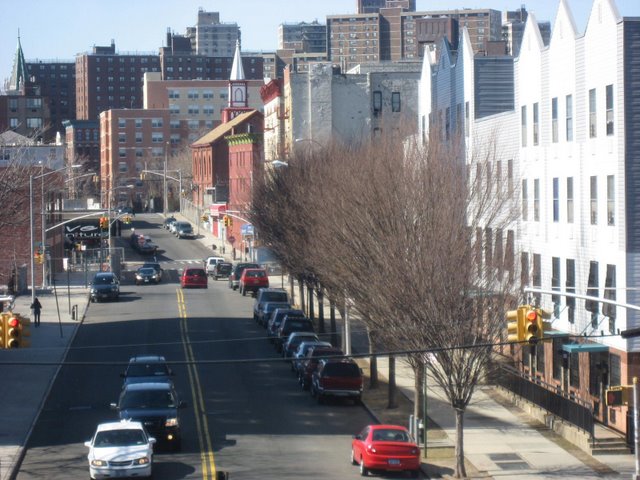
Row houses on a location where there was once burnt rubble. The Bronx has seen an increase in revitalization in recent years.
Since the late 1980s, significant development has occurred in the Bronx, first stimulated by the city's "Ten-Year Housing Plan"[62][63] and community members working to rebuild the social, economic and environmental infrastructure by creating affordable housing. Groups affiliated with churches in the South Bronx erected the Nehemiah Homes with about 1,000 units. The grass roots organization Nos Quedamos' endeavor known as Melrose Commons[64][65][66] began to rebuild areas in the South Bronx.[67] The IRT White Plains Road Line (2 and 5 trains) began to show an increase in riders. Chains such as Marshalls, Staples, and Target opened stores in the Bronx. More bank branches opened in the Bronx as a whole (rising from 106 in 1997 to 149 in 2007), although not primarily in poor or minority neighborhoods, while the Bronx still has fewer branches per person than other boroughs.[68][69][70][71]
In 1997, the Bronx was designated an All America City by the National Civic League, acknowledging its comeback from the decline of the mid-century.[72] In 2006, The New York Times reported that "construction cranes have become the borough's new visual metaphor, replacing the window decals of the 1980s in which pictures of potted plants and drawn curtains were placed in the windows of abandoned buildings."[73] The borough has experienced substantial new building construction since 2002. Between 2002 and June 2007, 33,687 new units of housing were built or were under way and $4.8 billion has been invested in new housing. In the first six months of 2007 alone total investment in new residential development was $965 million and 5,187 residential units were scheduled to be completed. Much of the new development is springing up in formerly vacant lots across the South Bronx.[74]
In addition, there is a revitalization of the existing housing market in areas such as Hunts Point, the Lower Concourse, and the neighborhoods surrounding the Third Avenue Bridge as people buy apartments and renovate them.[75] Several boutique and chain hotels have opened in recent years in the South Bronx.[76]
New developments are underway. The Bronx General Post Office[77][78] on the corner of the Grand Concourse and East 149th Street is being converted into a market place, boutiques, restaurants and office space with a USPS concession.[79] The Kingsbridge Armory, often cited as the largest armory in the world, is scheduled for redevelopment as the Kingsbridge National Ice Center.[80]
Under consideration for future development is the construction of a platform over the New York City Subway's Concourse Yard adjacent to Lehman College. The construction would permit approximately 2,000,000 square feet (190,000 m2) of development and would cost US$350–500 million.[81]
Geography
Location and physical features
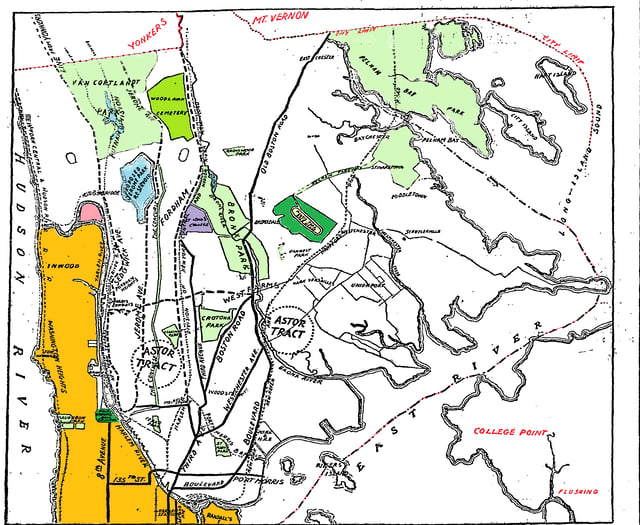
The New York Times 1896 map of parks and transit in the newly annexed Bronx. Marble Hill is in pink, cut off by water from the rest of Manhattan in orange. Parks are light green, Woodlawn Cemetery medium green, sports facilities dark green, the not-yet-built Jerome Park Reservoir light blue, St. John's College (now Fordham University) in violet, and the city limits of the newly expanded New York in red.[82]
According to the U.S. Census Bureau, Bronx County has a total area of 57 square miles (150 km2), of which 42 square miles (110 km2) is land and 15 square miles (39 km2) (27%) is water.[83]
The Bronx is New York City's northernmost borough, New York State's southernmost mainland county and the only part of New York City that is almost entirely situated on the North American mainland.[84] Its bedrock is primarily Fordham gneiss, a high-grade heavily banded metamorphic rock containing significant amounts of pink feldspar.[85] Marble Hill – politically part of Manhattan but now physically attached to the Bronx – is so-called because of the formation of Inwood marble there as well as in Inwood, Manhattan and parts of the Bronx and Westchester County.
The Hudson River separates the Bronx on the west from Alpine, Tenafly and Englewood Cliffs in Bergen County, New Jersey; the Harlem River separates it from the island of Manhattan to the southwest; the East River separates it from Queens to the southeast; and to the east, Long Island Sound separates it from Nassau County in western Long Island. Directly north of the Bronx are (from west to east) the adjoining Westchester County communities of Yonkers, Mount Vernon, Pelham Manor and New Rochelle. (There is also a short southern land boundary with Marble Hill in the Borough of Manhattan, over the filled-in former course of the Spuyten Duyvil Creek. Marble Hill's postal ZIP code, telephonic area codes and fire service, however, are shared with the Bronx and not Manhattan.)
The Bronx River flows south from Westchester County through the borough, emptying into the East River; it is the only entirely freshwater river in New York City.[86] A smaller river, the Hutchinson River (named after the religious leader Anne Hutchinson, killed along its banks in 1641), passes through the East Bronx and empties into Eastchester Bay.
The Bronx also includes several small islands in the East River and Long Island Sound, such as City Island and Hart Island. Rikers Island in the East River, home to the large jail complex for the entire city, is also part of the Bronx.
The Bronx's highest elevation at 280 feet (85 m) is in the northwest corner, west of Van Cortlandt Park and in the Chapel Farm area near the Riverdale Country School.[87] The opposite (southeastern) side of the Bronx has four large low peninsulas or "necks" of low-lying land that jut into the waters of the East River and were once salt marsh: Hunt's Point, Clason's Point, Screvin's Neck and Throggs Neck. Further up the coastline, Rodman's Neck lies between Pelham Bay Park in the northeast and City Island. The Bronx's irregular shoreline extends for 75 square miles (194 km2).[88]
Parks and open space
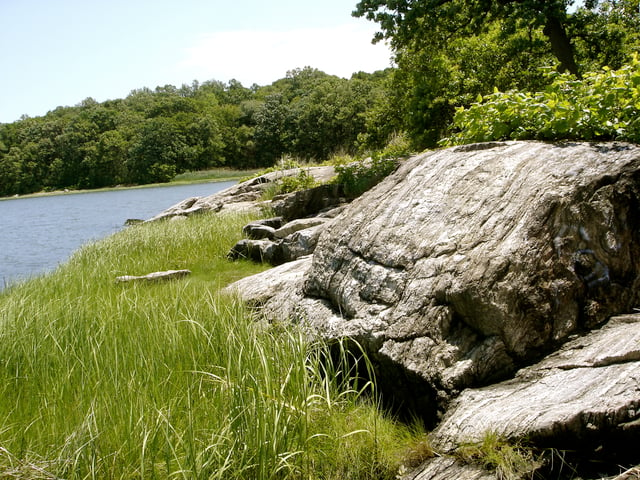
Northern tip of Hunter Island in Pelham Bay Park
| Sample of Bronx open spaces and parks | |||||
|---|---|---|---|---|---|
| Acquired | Name | acres | mi2 | hectares | |
| 1863 | Woodlawn Cemetery | 400 | 0.6 | 162 | |
| 1888 | Pelham Bay Park | 2,764 | 4.3 | 1,119 | |
| Van Cortlandt Park | 1,146 | 1.8 | 464 | ||
| Bronx Park | 718 | 1.1 | 291 | ||
| Crotona Park | 128 | 0.2 | 52 | ||
| St. Mary's Park | 35 | 0.05 | 14 | ||
| 1890 | Jerome Park Reservoir | 94 | 0.15 | 38 | |
| 1897 | St. James Park | 11 | 0.02 | 4.6 | |
| 1899 | Macombs Dam Park † | 28 | 0.04 | 12 | |
| 1909 | Henry Hudson Park | 9 | 0.01 | 4 | |
| 1937 | Ferry Point Park | 414 | 0.65 | 168 | |
| Soundview Park | 196 | 0.31 | 79 | ||
| 1962 | Wave Hill | 21 | 0.03 | 8.5 | |
| Land area of the Bronx in 2000 | 26,897 | 42.0 | 10,885 | ||
| Water area | 9,855 | 15.4 | 3,988 | ||
| Total area[83] | 36,752 | 57.4 | 14,873 | ||
| † closed in 2007 to build a new park & Yankee Stadium[89] | |||||
| Main source: New York City Department of Parks & Recreation [241] | |||||
Although Bronx County was the third most densely populated county in the United States as of 2006 (after Manhattan and Brooklyn),[5] 7,000 acres (28 km2) of the Bronx—about one-fifth of the Bronx's area, and one-quarter of its land area—is given over to parkland.[8] The vision of a system of major Bronx parks connected by park-like thoroughfares is usually attributed to John Mullaly.
Woodlawn Cemetery, one of the largest cemeteries in New York City, sits on the western bank of the Bronx River near Yonkers. It opened in 1863, at a time when the Bronx was still considered a rural area.
The northern side of the borough includes the largest park in New York City—Pelham Bay Park, which includes Orchard Beach—and the third-largest, Van Cortlandt Park, which is west of Woodlawn Cemetery and borders Yonkers.[90] Also in the northern Bronx, Wave Hill, the former estate of George W. Perkins—known for a historic house, gardens, changing site-specific art installations and concerts—overlooks the New Jersey Palisades from a promontory on the Hudson in Riverdale. Nearer the borough's center, and along the Bronx River, is Bronx Park; its northern end houses the New York Botanical Gardens, which preserve the last patch of the original hemlock forest that once covered the entire county, and its southern end the Bronx Zoo, the largest urban zoological gardens in the United States.[91] Just south of Van Cortlandt Park is the Jerome Park Reservoir, surrounded by 2 miles (3 km) of stone walls and bordering several small parks in the Bedford Park neighborhood; the reservoir was built in the 1890s on the site of the former Jerome Park Racetrack.[92] Further south is Crotona Park, home to a 3.3-acre (1.3 ha) lake, 28 species of trees, and a large swimming pool.[93] The land for these parks, and many others, was bought by New York City in 1888, while land was still open and inexpensive, in anticipation of future needs and future pressures for development.[94]
Some of the acquired land was set aside for the Grand Concourse and Pelham Parkway, the first of a series of boulevards and parkways (thoroughfares lined with trees, vegetation and greenery). Later projects included the Bronx River Parkway, which developed a road while restoring the riverbank and reducing pollution, Mosholu Parkway and the Henry Hudson Parkway.
In 2006, a five-year, $220-million program of capital improvements and natural restoration in 70 Bronx parks was begun (financed by water and sewer revenues) as part of an agreement that allowed a water filtration plant under Mosholu Golf Course in Van Cortlandt Park. One major focus is on opening more of the Bronx River's banks and restoring them to a natural state.[95]
Neighborhoods
The number, locations, and boundaries of the Bronx's neighborhoods (many of them sitting on the sites of 19th-century villages) have become unclear with time and successive waves of newcomers. In 2006, Manny Fernandez of The New York Times wrote,
According to a Department of City Planning map of the city's neighborhoods, the Bronx has 49. The map publisher Hagstrom identifies 69. The borough president, Adolfo Carrión Jr., says 61. The Mayor's Community Assistance Unit, in a listing of the borough's community boards, names 68. Wikipedia, the online encyclopedia, lists 44.[1][96]
Notable Bronx neighborhoods include the South Bronx; Little Italy on Arthur Avenue in the Belmont section; and Riverdale.
East Bronx
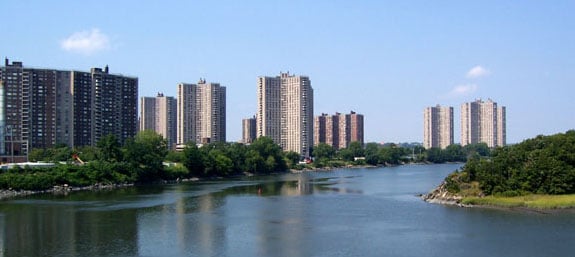
The neighborhood of Co-op City is the largest cooperative housing development in the world.
(Bronx Community Boards 9 [south central], 10 [east], 11 [east central] and 12 [north central] )[97]
East of the Bronx River, the borough is relatively flat and includes four large low peninsulas, or 'necks,' of low-lying land which jut into the waters of the East River and were once saltmarsh: Hunts Point, Clason's Point, Screvin's Neck (Castle Hill Point) and Throgs Neck. The East Bronx has older tenement buildings, low income public housing complexes, and multifamily homes, as well as single family homes. It includes New York City's largest park: Pelham Bay Park along the Westchester-Bronx border.
Neighborhoods include: Clason's Point, Harding Park, Soundview, Castle Hill, Parkchester (Board 9); Throggs Neck, Country Club, City Island, Pelham Bay, Edgewater Park, Co-op City (Board 10); Westchester Square, Van Nest, Pelham Parkway, Morris Park (Board 11); Williamsbridge, Eastchester, Baychester, Edenwald and Wakefield (Board 12).
City Island and Hart Island
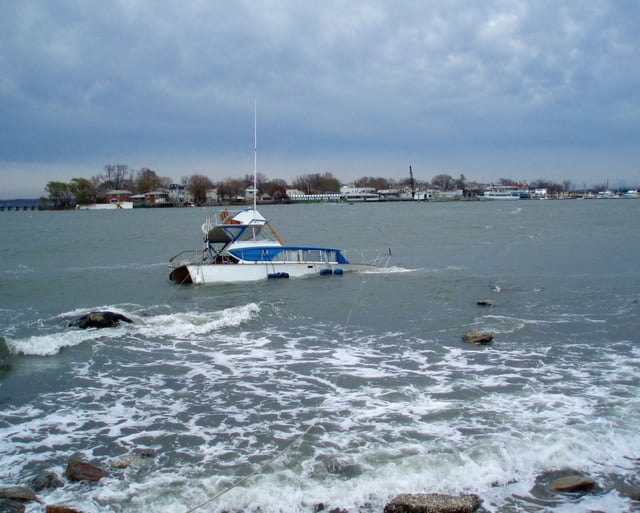
A sunken boat off the shore of City Island
(Bronx Community Board 10)
City Island is located east of Pelham Bay Park in Long Island Sound and is known for its seafood restaurants and private waterfront homes.[98] City Island's single shopping street, City Island Avenue, is reminiscent of a small New England town. It is connected to Rodman's Neck on the mainland by the City Island Bridge.
East of City Island is Hart Island, which is uninhabited and not open to the public. It once served as a prison and now houses New York City's potter's field for unclaimed bodies.[99]
West Bronx
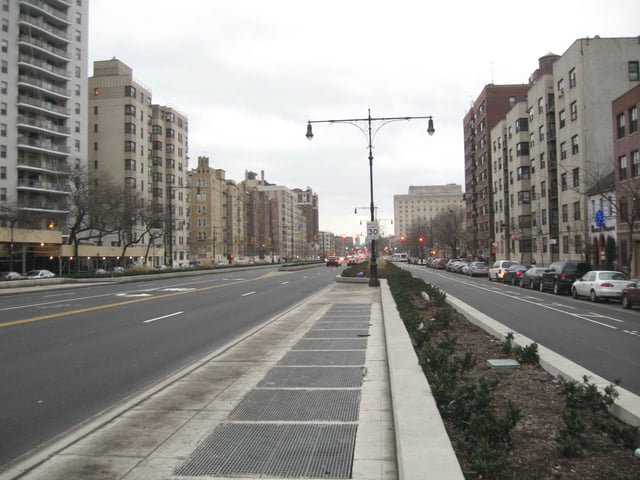
Grand Concourse at East 165th Street
(Bronx Community Boards 1 to 8, progressing roughly from south to northwest)
The western parts of the Bronx are hillier and are dominated by a series of parallel ridges, running south to north. The West Bronx has older apartment buildings, low income public housing complexes, multifamily homes in its lower income areas as well as larger single family homes in more affluent areas such as Riverdale and Fieldston.[100] It includes New York City's third-largest park: Van Cortlandt Park along the Westchester-Bronx border. The Grand Concourse, a wide boulevard, runs through it, north to south.
Northwestern Bronx
(Bronx Community Boards 7 [between the Bronx and Harlem Rivers] and 8 [facing the Hudson River] – plus part of Board 12)
Neighborhoods include: Fordham-Bedford, Bedford Park, Norwood, Kingsbridge Heights (Board 7), Kingsbridge, Riverdale (Board 8), and Woodlawn (Board 12). (Marble Hill, Manhattan is now connected by land to the Bronx rather than Manhattan and is served by Bronx Community Board 8.)
South Bronx
(Bronx Community Boards 1 to 6 plus part of Board 7—progressing northwards, Boards 2, 3 and 6 border the Bronx River from its mouth to Bronx Park, while 1, 4, 5 and 7 face Manhattan across the Harlem River)
Like other neighborhoods in New York City, the South Bronx has no official boundaries. The name has been used to represent poverty in the Bronx and is applied to progressively more northern places so that by the 2000s, Fordham Road was often used as a northern limit. The Bronx River more consistently forms an eastern boundary. The South Bronx has many high-density apartment buildings, low income public housing complexes, and multi-unit homes. The South Bronx is home to the Bronx County Courthouse, Borough Hall, and other government buildings, as well as Yankee Stadium. The Cross Bronx Expressway bisects it, east to west. The South Bronx has some of the poorest neighborhoods in the country, as well as very high crime areas.
Neighborhoods include: The Hub (a retail district at Third Avenue and East 149th Street), Port Morris, Mott Haven (Board 1), Melrose (Board 1 & Board 3), Morrisania, East Morrisania [also known as Crotona Park East] (Board 3), Hunts Point, Longwood (Board 2), Highbridge, Concourse (Board 4), West Farms, Belmont, East Tremont (Board 6), Tremont, Morris Heights (Board 5), University Heights. (Board 5 & Board 7).
Adjacent counties
The Bronx adjoins:[101]
Westchester County – north
Nassau County, New York – southeast (across the East River)
Queens County, New York (Queens) – south (across the East River)
New York County, New York (Manhattan) – southwest
Bergen County, New Jersey – west (across the Hudson River)
Transportation
Roads and streets
Surface streets
The Bronx street grid is irregular. Like the northernmost part of upper Manhattan, the West Bronx's hilly terrain leaves a relatively free-style street grid. Much of the West Bronx's street numbering carries over from upper Manhattan, but does not match it exactly; East 132nd Street is the lowest numbered street in the Bronx. This dates from the mid-19th century when the southwestern area of Westchester County west of the Bronx River, was incorporated into New York City and known as the Northside.
The East Bronx is considerably flatter, and the street layout tends to be more regular. Only the Wakefield neighborhood picks up the street numbering, albeit at a misalignment due to Tremont Avenue's layout. At the same diagonal latitude, West 262nd Street in Riverdale matches East 237th Street in Wakefield.
Three major north-south thoroughfares run between Manhattan and the Bronx: Third Avenue, Park Avenue, and Broadway. Other major north-south roads include the Grand Concourse, Jerome Avenue, Sedgwick Avenue, Webster Avenue, and White Plains Road. Major east-west thoroughfares include Mosholu Parkway, Gun Hill Road, Fordham Road, Pelham Parkway, and Tremont Avenue.
Most east-west streets are prefixed with either East or West, to indicate on which side of Jerome Avenue they lie (continuing the similar system in Manhattan, which uses Fifth Avenue as the dividing line).[102]
The historic Boston Post Road, part of the long pre-revolutionary road connecting Boston with other northeastern cities, runs east-west in some places, and sometimes northeast-southwest.
Mosholu and Pelham Parkways, with Bronx Park between them, Van Cortlandt Park to the west and Pelham Bay Park to the east, are also linked by bridle paths.
As of the 2000 Census, approximately 61.6% of all Bronx households do not have access to a car. Citywide, the percentage of autoless households is 55%.[103]
Highways
Several major limited access highways traverse the Bronx. These include:
the Bronx River Parkway
the Bruckner Expressway (I-278/I-95)
the Cross Bronx Expressway (I-95/I-295)
the New England Thruway (I-95)
the Henry Hudson Parkway (NY-9A)
the Hutchinson River Parkway
the Major Deegan Expressway (I-87)
Bridges and tunnels

An aerial view of the Throgs Neck Bridge
Thirteen bridges and three tunnels connect the Bronx to Manhattan, and three bridges connect the Bronx to Queens. These are, from west to east:
To Manhattan: the Spuyten Duyvil Bridge, the Henry Hudson Bridge, the Broadway Bridge, the University Heights Bridge, the Washington Bridge, the Alexander Hamilton Bridge, the High Bridge, the Concourse Tunnel, the Macombs Dam Bridge, the 145th Street Bridge, the 149th Street Tunnel, the Madison Avenue Bridge, the Park Avenue Bridge, the Lexington Avenue Tunnel, the Third Avenue Bridge (southbound traffic only), and the Willis Avenue Bridge (northbound traffic only).
To both Manhattan and Queens: the Robert F. Kennedy Bridge, formerly known as the Triborough Bridge.
To Queens: the Bronx–Whitestone Bridge and the Throgs Neck Bridge.
Mass transit
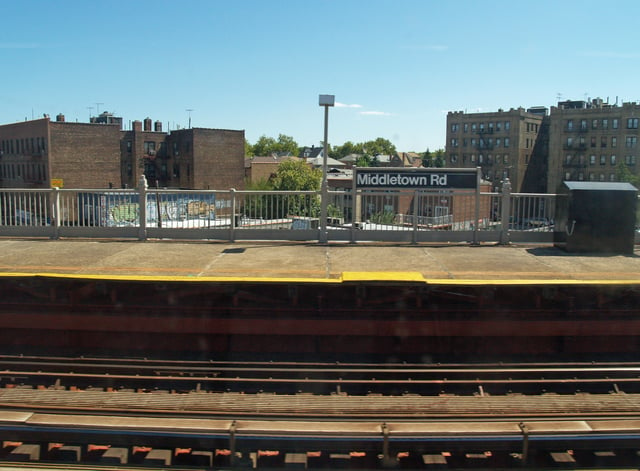
Middletown Road subway station on the 6 and <6> trains

NYC Transit bus operating on the Bx40 route in University Heights
The Bronx is served by seven New York City Subway services along six physical lines, with 70 stations in the Bronx:[104]
IND Concourse Line (B and D trains)
IRT Broadway–Seventh Avenue Line (1 train)
IRT Dyre Avenue Line (5 train)
IRT Jerome Avenue Line (4 train)
IRT Pelham Line (6 and <6> trains)
IRT White Plains Road Line (2 and 5 trains)
There are also many MTA Regional Bus Operations bus routes in the Bronx. This includes local and express routes as well as Bee-Line Bus System routes.[105]
Two Metro-North Railroad commuter rail lines (the Harlem Line and the Hudson Line) serve 11 stations in the Bronx. (Marble Hill, between the Spuyten Duyvil and University Heights stations, is actually in the only part of Manhattan connected to the mainland.) In addition, trains serving the New Haven Line stop at Fordham Plaza. As part of Penn Station Access, the 2018 MTA budget funded construction of four new stops along the New Haven Line to serve Hunts Point, Parkchester, Morris Park, and Co-op City.[106]
In 2018, NYC Ferry's Soundview line opened, connecting the Soundview landing in Clason Point Park to three East River locations in Manhattan. The ferry is operated by Hornblower Cruises.[107]
Demographics
Race, ethnicity, language, and immigration
2013 estimates
According to a 2013 Census Bureau estimate,[108] 45.8% of the Bronx's population was white, 43.3% was black or African American, 4.2% Asian, 3.0% American Indian, 0.4% Pacific Islander, and 3.3% of two or more races. In addition, 54.6% of the population was of Hispanic or Latino origin, of any race.
The Census Bureau considers the Bronx to be the most diverse area in the country. There is an 89.7 percent chance that any two residents, chosen at random, would be of different race or ethnicity.[109] The borough's most populous racial group, white, declined from 98.3% in 1940 to 45.8% in 2013.[108]
31.7% of the population were foreign born and another 8.9% were born in Puerto Rico, U.S. Island areas, or born abroad to American parents. 55.6% spoke a language other than English at home and 16.4% had a bachelor's degree or higher.[110]
2010 Census
| Historical population | |||
|---|---|---|---|
| Census | Pop. | %± | |
| 1790 | 1,781 | — | |
| 1800 | 1,755 | −1.5% | |
| 1810 | 2,267 | 29.2% | |
| 1820 | 2,782 | 22.7% | |
| 1830 | 3,023 | 8.7% | |
| 1840 | 5,346 | 76.8% | |
| 1850 | 8,032 | 50.2% | |
| 1860 | 23,593 | 193.7% | |
| 1870 | 37,393 | 58.5% | |
| 1880 | 51,980 | 39.0% | |
| 1890 | 88,908 | 71.0% | |
| 1900 | 200,507 | 125.5% | |
| 1910 | 430,980 | 114.9% | |
| 1920 | 732,016 | 69.8% | |
| 1930 | 1,265,258 | 72.8% | |
| 1940 | 1,394,711 | 10.2% | |
| 1950 | 1,451,277 | 4.1% | |
| 1960 | 1,424,815 | −1.8% | |
| 1970 | 1,471,701 | 3.3% | |
| 1980 | 1,168,972 | −20.6% | |
| 1990 | 1,203,789 | 3.0% | |
| 2000 | 1,332,650 | 10.7% | |
| 2010 | 1,385,108 | 3.9% | |
| Est. 2017 | 1,471,160 | [3] | 6.2% |
| Sources: 1790–1990;[113] | |||
According to the 2010 Census, 53.5% of Bronx's population was of Hispanic, Latino, or Spanish origin (they may be of any race); 30.1% non-Hispanic Black or African American, 10.9% of the population was non-Hispanic White, 3.4% non-Hispanic Asian, 0.6% from some other race (non-Hispanic) and 1.2% of two or more races (non-Hispanic).
As of 2010, 46.29% (584,463) of Bronx residents aged five and older spoke Spanish at home, while 44.02% (555,767) spoke English, 2.48% (31,361) African languages, 0.91% (11,455) French, 0.90% (11,355) Italian, 0.87% (10,946) various Indic languages, 0.70% (8,836) other Indo-European languages, and Chinese was spoken at home by 0.50% (6,610) of the population over the age of five. In total, 55.98% (706,783) of the Bronx's population age five and older spoke a language at home other than English.[114] A Garifuna-speaking community from Honduras and Guatemala also makes the Bronx its home.[115]
2009 Community Survey
According to the 2009 American Community Survey, White Americans of both Hispanic and non-Hispanic origin represented over one-fifth (22.9%) of the Bronx's population. However, non-Hispanic whites formed under one-eighth (12.1%) of the population, down from 34.4% in 1980.[116] Out of all five boroughs, the Bronx has the lowest number and percentage of white residents. 320,640 whites called the Bronx home, of which 168,570 were non-Hispanic whites. The majority of the non-Hispanic European American population is of Italian and Irish descent. People of Italian descent numbered over 55,000 individuals and made up 3.9% of the population. People of Irish descent numbered over 43,500 individuals and made up 3.1% of the population. German Americans and Polish Americans made up 1.4% and 0.8% of the population respectively.
The Bronx is the only New York City borough with a Hispanic majority, many of whom are Puerto Ricans and Dominicans.
At the 2009 American Community Survey, Black Americans made the second largest group in the Bronx after Hispanics and Latinos. Blacks of both Hispanic and non-Hispanic origin represented over one-third (35.4%) of the Bronx's population. Blacks of non-Hispanic origin made up 30.8% of the population. Over 495,200 blacks resided in the borough, of which 430,600 were non-Hispanic blacks. Over 61,000 people identified themselves as "Sub-Saharan African" in the survey, making up 4.4% of the population.
Native Americans are a very small minority in the borough. Only some 5,560 individuals (out of the borough's 1.4 million people) are Native American, which is equal to just 0.4% of the population. In addition, roughly 2,500 people are Native Americans of non-Hispanic origin.
In 2009, Hispanic and Latino Americans represented 52.0% of the Bronx's population. Puerto Ricans represented 23.2% of the borough's population. Over 72,500 Mexicans lived in the Bronx, and they formed 5.2% of the population. Cubans numbered over 9,640 members and formed 0.7% of the population. In addition, over 319,000 people were of various Hispanic and Latino groups, such as Dominican, Salvadoran, and so on. These groups collectively represented 22.9% of the population. At the 2010 Census, 53.5% of Bronx's population was of Hispanic, Latino, or Spanish origin (they may be of any race). Asian Americans are a small but sizable minority in the borough. Roughly 49,600 Asians make up 3.6% of the population. Roughly 13,600 Indians call the Bronx home, along with 9,800 Chinese, 6,540 Filipinos, 2,260 Vietnamese, 2,010 Koreans, and 1,100 Japanese.
Multiracial Americans are also a sizable minority in the Bronx. People of multiracial heritage number over 41,800 individuals and represent 3.0% of the population. People of mixed Caucasian and African American heritage number over 6,850 members and form 0.5% of the population. People of mixed Caucasian and Native American heritage number over 2,450 members and form 0.2% of the population. People of mixed Caucasian and Asian heritage number over 880 members and form 0.1% of the population. People of mixed African American and Native American heritage number over 1,220 members and form 0.1% of the population.
Older estimates
The Census of 1930 counted only 1.0% (12,930) of the Bronx's population as Negro (while making no distinct counts of Hispanic or Spanish-surname residents).[117]
| Foreign or overseas birthplaces of Bronx residents, 1930 and 2000 | |||||
|---|---|---|---|---|---|
| 1930 United States Census[117] | 2000 United States Census[118] | ||||
| Total population of the Bronx | 1,265,258 | Total population of the Bronx | 1,332,650 | ||
| All born abroad or overseas‡ | 524,410 | 39.4% | |||
| Puerto Rico | 126,649 | 9.5% | |||
| Foreign-born Whites | 477,342 | 37.7% | All foreign-born | 385,827 | 29.0% |
| White persons born in Russia | 135,210 | 10.7% | Dominican Republic | 124,032 | 9.3% |
| White persons born in Italy | 67,732 | 5.4% | Jamaica | 51,120 | 3.8% |
| White persons born in Poland | 55,969 | 4.4% | Mexico | 20,962 | 1.6% |
| White persons born in Germany | 43,349 | 3.4% | Guyana | 14,868 | 1.1% |
| White persons born in the Irish Free State† | 34,538 | 2.7% | Ecuador | 14,800 | 1.1% |
| Other foreign birthplaces of Whites | 140,544 | 11.1% | Other foreign birthplaces | 160,045 | 12.0% |
| † now the Republic of Ireland | ‡ beyond the 50 states & District of Columbia | ||||
Population and housing

Poverty concentrations within the Bronx, by Census Tract
At the 2010 Census, there were, 1,385,108 people living in Bronx, a 3.9% increase since 2000. As of the United States Census[119] of 2000, there were 1,332,650 people, 463,212 households, and 314,984 families residing in the borough. The population density was 31,709.3 inhabitants per square mile (12,242.2/km2). There were 490,659 housing units at an average density of 11,674.8 per square mile (4,507.4/km2).[119] Recent Census estimates place total population of Bronx county at 1,392,002 as of 2012.[120]
There were 463,212 households out of which 38.1% had children under the age of 18 living with them, 31.4% were married couples living together, 30.4% had a female householder with no husband present, and 32.0% were non-families. 27.4% of all households were made up of individuals and 9.4% had someone living alone who was 65 years of age or older. The average household size was 2.78 and the average family size was 3.37.[119]
The age distribution of the population in the Bronx was as follows: 29.8% under the age of 18, 10.6% from 18 to 24, 30.7% from 25 to 44, 18.8% from 45 to 64, and 10.1% 65 years of age or older. The median age was 31 years. For every 100 females, there were 87.0 males.[119]
Individual and household income
The 1999 median income for a household in the borough was $27,611, and the median income for a family was $30,682. Males had a median income of $31,178 versus $29,429 for females. The per capita income for the borough was $13,959. About 28.0% of families and 30.7% of the population were below the poverty line, including 41.5% of those under age 18 and 21.3% of those age 65 or over.
From 2015 Census data, the median income for a household was (in 2015 dollars) $34,299. Per capita income in past 12 months (in 2015 dollars): $18,456 with persons in poverty at 30.3%. Per the 2016 Census data, the median income for a household was $35,302. Per capita income was cited at $18,896.[121]
Government and politics
Local government
Since New York City's consolidation in 1898, the Bronx has been governed by the New York City Charter that provides for a "strong" mayor-council system. The centralized New York City government is responsible for public education, correctional institutions, libraries, public safety, recreational facilities, sanitation, water supply, and welfare services in the Bronx.
| Borough Presidents of the Bronx | ||
|---|---|---|
| Name | Party | Term † |
| Louis F. Haffen | Democratic | 1898 – Aug. 1909 |
| John F. Murray | Democratic | Aug. 1909–1910 |
| Cyrus C. Miller | Democratic | 1910–1914 |
| Douglas Mathewson | Republican- Fusion | 1914–1918 |
| Henry Bruckner | Democratic | 1918–1934 |
| James J. Lyons | Democratic | 1934–1962 |
| Joseph F. Periconi | Republican- Liberal | 1962–1966 |
| Herman Badillo | Democratic | 1966–1970 |
| Robert Abrams | Democratic | 1970–1979 |
| Stanley Simon | Democratic | 1979 – April 1987 |
| Fernando Ferrer | Democratic | April 1987 – 2002 |
| Adolfo Carrión, Jr. | Democratic | 2002 – March 2009 |
| Ruben Diaz, Jr. | Democratic | May 2009 – |
| † Terms begin and end in January where the month is not specified. | ||
The office of Borough President was created in the consolidation of 1898 to balance centralization with local authority. Each borough president had a powerful administrative role derived from having a vote on the New York City Board of Estimate, which was responsible for creating and approving the city's budget and proposals for land use. In 1989 the Supreme Court of the United States declared the Board of Estimate unconstitutional on the grounds that Brooklyn, the most populous borough, had no greater effective representation on the Board than Staten Island, the least populous borough, a violation of the Fourteenth Amendment's Equal Protection Clause pursuant to the high court's 1964 "one man, one vote" decision.[122]
Since 1990 the Borough President has acted as an advocate for the borough at the mayoral agencies, the City Council, the New York state government, and corporations.
Until March 1, 2009, the Borough President of the Bronx was Adolfo Carrión Jr., elected as a Democrat in 2001 and 2005 before retiring early to direct the White House Office of Urban Affairs Policy. His successor, Democratic New York State Assembly member Rubén Díaz, Jr., who won a special election on April 21, 2009 by a vote of 86.3% (29,420) on the "Bronx Unity" line to 13.3% (4,646) for the Republican district leader Anthony Ribustello on the "People First" line,[123][124] became Borough President on May 1.
All of the Bronx's currently elected public officials have first won the nomination of the Democratic Party (in addition to any other endorsements). Local party platforms center on affordable housing, education and economic development. Controversial political issues in the Bronx include environmental issues, the cost of housing, and annexation of parkland for new Yankee Stadium.
Since its separation from New York County on January 1, 1914, the Bronx, has had, like each of the other 61 counties of New York State, its own criminal court system[7] and District Attorney, the chief public prosecutor who is directly elected by popular vote. Darcel D. Clark has been the Bronx County District Attorney since 2016. Her predecessor was Robert T. Johnson, was the District Attorney from 1989 to 2015. He was the first African-American District Attorney in New York State.
Eight members of the New York City Council represent districts wholly within the Bronx (11–18), while a ninth represents a Manhattan district (8) that also includes a small area of the Bronx. One of those members, Joel Rivera (District 15), has been the Council's Majority Leader since 2002. In 2008, all of them were Democrats.
The Bronx also has twelve Community Boards, appointed bodies that field complaints and advise on land use and municipal facilities and services for local residents, businesses and institutions. (They are listed at Bronx Community Boards).
Representatives in the U.S. Congress
| Candidates winning non-judicial elections in the Bronx since 2004 | ||||
| Year | Office | Winner of the Bronx † (failed to win overall contest) | Bronx % | Over- all % |
|---|---|---|---|---|
| Borough-wide votes | ||||
| 2004 | U.S. President & V.P. | † John Kerry–John Edwards, D-WF | 81.8% | 48.3% |
| 2005 | Mayor of New York | † Fernando Ferrer, D | 59.8% | 39.0% |
| Public Advocate | Betsy Gotbaum, D | 93.8% | 90.0% | |
| City Comptroller | William C. Thompson, Jr., D-WF | 95.5% | 92.6% | |
| Borough President | Adolfo Carrión, Jr., D | 83.8% | ||
| 2006 | U.S. Senator | Hillary Clinton, D-WF-Independence | 89.5% | 67.0% |
| Governor & Lt Gov. | Eliot Spitzer–David Paterson, D-WF-Indpce | 88.8% | 69.0% | |
| State Comptroller | Alan G. Hevesi, D-WF-Independence | 84.5% | 56.8% | |
| NY Attorney-General | Andrew M. Cuomo, D-Working Families | 82.6% | 58.3% | |
| 2007 | Bronx Dist. Attorney | Robert T. Johnson, D-R-Conservative | 100–% | |
| 2008 | Democratic Pres. | † Hillary Clinton | 61.2% | 48.0% |
| Republican Pres. | John McCain | 54.4% | 46.6% | |
| U.S. President & V.P. | Barack Obama–Joe Biden, D-WF | 87.8% | 52.9% | |
| 2009 | Borough President | Ruben Diaz, Jr., Bronx Unity | 86.3% | |
| Individual legislative districts | ||||
| 2005 | New York City Council | |||
| Council District 8 | Melissa Mark Viverito, D-WF | 100.% | 100.% | |
| Council District 11 | G. Oliver Koppell, D | 81.1% | ||
| Council District 12 | Larry B. Seabrook, D | 87.2% | ||
| Council District 13 | James Vacca, D | 64.4% | ||
| Council District 14 | María Baez, D | 94.7% | ||
| Council District 15 | Joel Rivera, D (majority leader) | 91.0% | ||
| Council District 16 | Helen D. Foster, D-R-Working Families | 98.6% | ||
| Council District 17 | María Del Carmen Arroyo, D-Indep'ce | 98.3% | ||
| Council District 18 | Annabel Palma, D-WF | 89.1% | ||
| 2006 | U.S. House of Representatives | |||
| Cong. District 7 | Joseph Crowley, D-WF | 84.9% | 84.0% | |
| Cong. District 16 | José E. Serrano, D-WF | 95.3% | ||
| Cong. District 17 | Eliot L. Engel, D-WF | 89.3% | 76.4% | |
| New York State Senate | ||||
| Senate District 28 | José M. Serrano, D-WF | 100.% | 100.% | |
| Senate District 31 | Eric T. Schneiderman, D-WF | 88.8% | 92.3% | |
| Senate District 32 | Rubén Díaz, D | 92.5% | ||
| Senate District 33 | Efraín González, Jr., D | 96.9% | ||
| Senate District 34 | Jeffrey D. Klein, D-WF | 64.8% | 61.2% | |
| Senate District 36 | Ruth H. Thompson, D-WF | 95.4% | 95.4% | |
| New York State Assembly | ||||
| Assembly District 76 | Peter M. Rivera, D-WF | 91.8% | ||
| Assembly District 77 | Aurelia Greene, D-WF | 94.9% | ||
| Assembly District 78 | José Rivera, D | 89.7% | ||
| Assembly District 79 | Michael A. Benjamin, D | 95.1% | ||
| Assembly District 80 | Naomi Rivera, D | 74.6% | ||
| Assembly District 81 | Jeffrey Dinowitz, D-WF | 95.1% | ||
| Assembly District 82 | Michael R. Benedetto, D-WF | 81.4% | ||
| Assembly District 83 | Carl E. Heastie, D-WF | 94.1% | ||
| Assembly District 84 | Carmen E. Arroyo, D | 92.7% | ||
| Assembly District 85 | Rubén Díaz, Jr., D | 94.8% | ||
| Assembly District 86 | Luís M. Diaz, D | 94.6% | ||
| D = Democratic Party; R = Republican Party; WF = Working Families Party; Indpce = Independence Party of New York | ||||
In 2018, four Democrats represented all of the Bronx in the United States House of Representatives.[125]
Adriano Espaillat (first elected in 2016) represents New York's 13th congressional district, which includes the northwest Bronx neighborhoods of Norwood, Bedford Park and Kingsbridge, as well as upper Manhattan.[125]
Alexandria Ocasio-Cortez (first elected in 2018) represents New York's 14th congressional district, which includes the East Bronx neighborhoods of Co-op City, Pelham Bay, Morris Park, Pelham Parkway, Parkchester, Castle Hill and Throgs Neck, as well as the Rikers Island jail complex and parts of northwest Queens.[125]
José E. Serrano (first elected in March 1990) represents New York's 15th congressional district, which includes neighborhoods in the South Bronx.[125]
Eliot Engel (first elected in 1988) represents New York's 16th congressional district which includes the northwest Bronx neighborhoods of Bedford Park, Spuyten Duyvil, and Riverdale as well as parts of Westchester and Rockland counties.[125]
National Journal's neutral rating system placed all of their voting records in 2005 and 2006 somewhere between very liberal and extremely liberal.[14][15]
11 out of 150 members of the New York State Assembly (the lower house of the state legislature) represent districts wholly within the Bronx. Six State Senators out of 62 represent Bronx districts, half of them wholly within the County, and half straddling other counties. All these legislators are Democrats who won between 65% and 100% of their districts' vote in 2006.[126]
Votes for other offices
In the 2004 presidential election, Senator John Kerry received 81.8% of the vote in the Bronx (79.8% on the Democratic line plus 2% on the Working Families Party's line) while President George W. Bush received 16.3% (15.5% Republican plus 0.85% Conservative).
In the 2008 presidential election, Democrat Barack Obama improved on Kerry's showing, and took 88.7% of the vote in the Bronx to Republican John McCain's 10.9%.
In 2005, the Democratic former Bronx Borough President Fernando Ferrer won 59.8% of the borough's vote against 38.8% (35.3% Republican, 3.5% Independence Party) for Mayor Michael Bloomberg, who carried every other borough in his winning campaign for re-election.
In 2006, successfully reelected Senator Hillary Clinton won 89.5% of the Bronx's vote (82.8% Dem. + 4.1% Working Families + 2.6% Independence) against Yonkers ex-Mayor John Spencer's 9.6% (8.2% Republican + 1.4% Cons.), while Eliot Spitzer won 88.8% of the Borough's vote (82.1% Dem. + 4.1% Working Families + 2.5% Independence Party) in winning the Governorship against John Faso, who received 9.7% of the Bronx's vote (8.2% Republican + 1.5% Cons.)[127]
In the Presidential primary elections of February 5, 2008, Sen. Clinton won 61.2% of the Bronx's 148,636 Democratic votes against 37.8% for Barack Obama and 1.0% for the other four candidates combined (John Edwards, Dennis Kucinich, Bill Richardson and Joe Biden). On the same day, John McCain won 54.4% of the borough's 5,643 Republican votes, Mitt Romney 20.8%, Mike Huckabee 8.2%, Ron Paul 7.4%, Rudy Giuliani 5.6%, and the other candidates (Fred Thompson, Duncan Hunter and Alan Keyes) 3.6% between them.[128]
After becoming a separate county in 1914, the Bronx has supported only two Republican Presidential candidates. It voted heavily for the winning Republican Warren G. Harding in 1920, but much more narrowly on a split vote for his victorious Republican successor Calvin Coolidge in 1924 (Coolidge 79,562; John W. Davis, Dem., 72,834; Robert La Follette, 62,202 equally divided between the Progressive and Socialist lines).
Since then, the Bronx has always supported the Democratic Party's nominee for President, starting with a vote of 2–1 for the unsuccessful Al Smith in 1928, followed by four 2–1 votes for the successful Franklin D. Roosevelt. (Both had been Governors of New York, but Republican former Gov. Thomas E. Dewey won only 28% of the Bronx's vote in 1948 against 55% for Pres. Harry Truman, the winning Democrat, and 17% for Henry A. Wallace of the Progressives. It was only 32 years earlier, by contrast, that another Republican former Governor who narrowly lost the Presidency, Charles Evans Hughes, had won 42.6% of the Bronx's 1916 vote against Democratic President Woodrow Wilson's 49.8% and Socialist candidate Allan Benson's 7.3%.)[129]
The Bronx has often shown striking differences from other boroughs in elections for Mayor. The only Republican to carry the Bronx since 1914 was Fiorello La Guardia in 1933, 1937 and 1941 (and in the latter two elections, only because his 30% to 32% vote on the American Labor Party line was added to 22% to 23% as a Republican).[130] The Bronx was thus the only borough not carried by the successful Republican re-election campaigns of Mayors Rudolph Giuliani in 1997 and Michael Bloomberg in 2005. The anti-war Socialist campaign of Morris Hillquit in the 1917 mayoral election won over 31% of the Bronx's vote, putting him second and well ahead of the 20% won by the incumbent pro-war Fusion Mayor John P. Mitchel, who came in second (ahead of Hillquit) everywhere else and outpolled Hillquit citywide by 23.2% to 21.7%.[131]
The Bronx County vote for President and Mayor since 1952 | |||||||
| President and Vice President of the United States | Mayor of the City of New York | ||||||
| Year | Republican, Conservative & Independence | Democratic, Liberal & Working Families | Won the Bronx | Elected President | Year | Candidate carrying the Bronx | Elected Mayor |
|---|---|---|---|---|---|---|---|
| 2016 | 9.5% 37,797 | 88.5% 353,646 | Hillary Clinton | Donald Trump | 2017 | Bill de Blasio, D-Working Families | Bill de Blasio, D-Working Families |
| 2012 | 8.1% 29,967 | 91.5% 339,211 | Barack Obama | Barack Obama | 2013 | Bill de Blasio, D-Working Families | Bill de Blasio, D-Working Families |
| 2008 | 10.9% 41,683 | 88.7% 338,261 | Barack Obama | Barack Obama | 2009 | William C. Thompson, Jr, D-Working Families | Michael Bloomberg, R–Indep'ce/Jobs & Educ'n |
| 2004 | 16.3% 56,701 | 81.8% 283,994 | John Kerry | George W. Bush | 2005 | Fernando Ferrer, D | Mike Bloomberg, R/Lib-Indep'ce |
| 2000 | 11.8% 36,245 | 86.3% 265,801 | Al Gore | George W. Bush | 2001 | Mark Green, D-Working Families | Michael Bloomberg, R-Independence |
| 1996 | 10.5% 30,435 | 85.8% 248,276 | Bill Clinton | Bill Clinton | 1997 | Ruth Messinger, D | Rudolph Giuliani, R-Liberal |
| 1992 | 20.7% 63,310 | 73.7% 225,038 | Bill Clinton | Bill Clinton | 1993 | David Dinkins, D | Rudolph Giuliani, R-Liberal |
| 1988 | 25.5% 76,043 | 73.2% 218,245 | Michael Dukakis | George H. W. Bush | 1989 | David Dinkins, D | David Dinkins, D |
| 1984 | 32.8% 109,308 | 66.9% 223,112 | Walter Mondale | Ronald Reagan | 1985 | Edward Koch, D-Indep. | Edward Koch, D-Independent |
| 1980 | 30.7% 86,843' | 64.0% 181,090 | Jimmy Carter | Ronald Reagan | 1981 | Edward Koch, D-R | Edward Koch, D-R |
| 1976 | 28.7% 96,842 | 70.8% 238,786 | Jimmy Carter | Jimmy Carter | 1977 | Edward Koch, D | Edward Koch, D |
| 1972 | 44.6% 196,756 | 55.2% 243,345 | George McGovern | Richard Nixon | 1973 | Abraham Beame, D | Abraham Beame, D |
| 1968 | 32.0% 142,314 | 62.4% 277,385 | Hubert Humphrey | Richard Nixon | 1969 | Mario Procaccino, D-Nonpartisan-Civil Svce Ind. | John V. Lindsay, Liberal |
| 1964 | 25.2% 135,780 | 74.7% 403,014 | Lyndon B. Johnson | Lyndon B. Johnson | 1965 | Abraham Beame, D-Civil Service Fusion | John Lindsay, R-Liberal-Independent Citizens |
| 1960 | 31.8% 182,393 | 67.9% 389,818 | John F. Kennedy | John F. Kennedy | 1961 | Robert F. Wagner, Jr., D-Liberal-Brotherhood | Robert F. Wagner, Jr., D-Liberal-Brotherhood |
| 1956 | 42.8% 256,909 | 57.2% 343,656 | Adlai Stevenson II | Dwight D. Eisenhower | 1957 | Robert F. Wagner, Jr., D-Liberal-Fusion | Robert F. Wagner, Jr., D-Liberal-Fusion |
| 1952 | 37.3% 241,898 | 60.6% 309,482 | Adlai Stevenson II | Dwight D. Eisenhower | 1953 | Robert F. Wagner, Jr., D | Robert F. Wagner, Jr., D |
Republican and Democratic columns for Presidential elections also include their candidates' votes on other lines, such as the New York State Right to Life Party and the Working Families Party.
For details of votes and parties in a particular election, click the year or see New York City mayoral elections.
| Year | Republican | Democratic | Third parties |
|---|---|---|---|
| 2016 | 9.5% 37,797 | 88.5% 353,646 | 2.0% 8,079 |
| 2012 | 8.1% 29,967 | 91.5% 339,211 | 0.5% 1,760 |
| 2008 | 10.9% 41,683 | 88.7% 338,261 | 0.4% 1,378 |
| 2004 | 16.5% 56,701 | 82.8% 283,994 | 0.7% 2,284 |
| 2000 | 11.8% 36,245 | 86.3% 265,801 | 2.0% 6,017 |
| 1996 | 10.5% 30,435 | 85.8% 248,276 | 3.7% 10,639 |
| 1992 | 20.7% 63,310 | 73.7% 225,038 | 5.6% 17,112 |
| 1988 | 25.5% 76,043 | 73.2% 218,245 | 1.3% 3,793 |
| 1984 | 32.8% 109,308 | 66.9% 223,112 | 0.4% 1,263 |
| 1980 | 30.7% 86,843 | 64.0% 181,090 | 5.3% 14,914 |
| 1976 | 28.7% 96,842 | 70.8% 238,786 | 0.5% 1,763 |
| 1972 | 44.6% 196,754 | 55.2% 243,345 | 0.2% 1,075 |
| 1968 | 32.0% 142,314 | 62.4% 277,385 | 5.6% 24,818 |
| 1964 | 25.2% 135,780 | 74.7% 403,014 | 0.2% 800 |
| 1960 | 31.8% 182,393 | 67.9% 389,818 | 0.4% 2,071 |
| 1956 | 42.8% 257,382 | 57.2% 343,823 | 0.0% 0 |
| 1952 | 37.3% 241,898 | 60.6% 392,477 | 2.1% 13,420 |
| 1948 | 27.8% 173,044 | 54.2% 337,129 | 18.0% 112,182 |
| 1944 | 31.8% 211,158 | 67.7% 450,525 | 0.5% 3,352 |
| 1940 | 31.8% 198,293 | 67.1% 418,931 | 1.1% 6,980 |
| 1936 | 17.6% 93,151 | 79.4% 419,625 | 3.0% 16,042 |
| 1932 | 19.2% 76,587 | 70.4% 281,330 | 10.5% 42,002 |
| 1928 | 28.7% 98,636 | 67.7% 232,766 | 3.7% 12,545 |
| 1924 | 36.7% 79,583 | 33.6% 72,840 | 29.6% 64,234 |
| 1920 | 56.6% 106,050 | 24.4% 45,741 | 19.0% 35,538 |
| 1916 | 42.6% 40,938 | 49.8% 47,870 | 7.7% 7,396 |
Economy
Shopping malls and markets in the Bronx include:
Bay Plaza Shopping Center
Bronx Terminal Market
Hunts Point Cooperative Market
Shopping districts

The Hub on Third Avenue
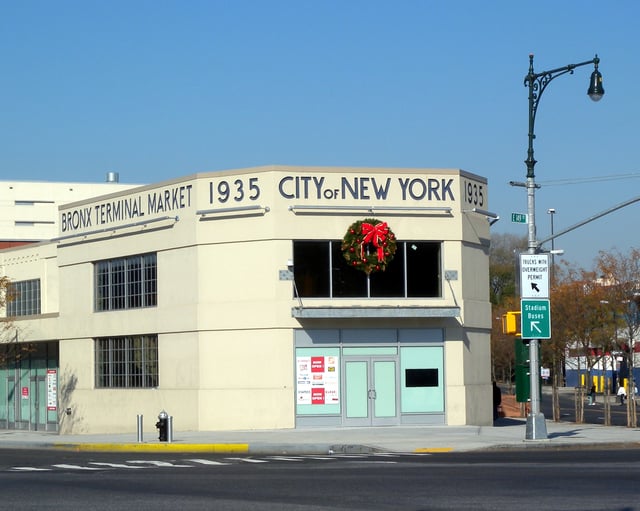
Renovated Prow Building, part of the original Bronx Terminal Market
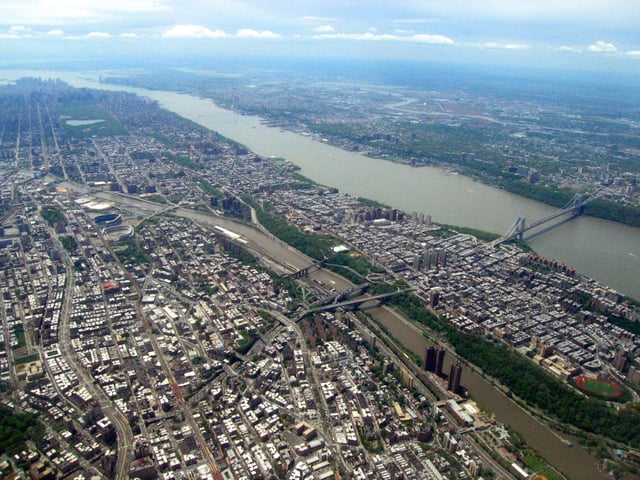
An aerial view of the Bronx, Harlem River, Harlem, Hudson River, and George Washington Bridge
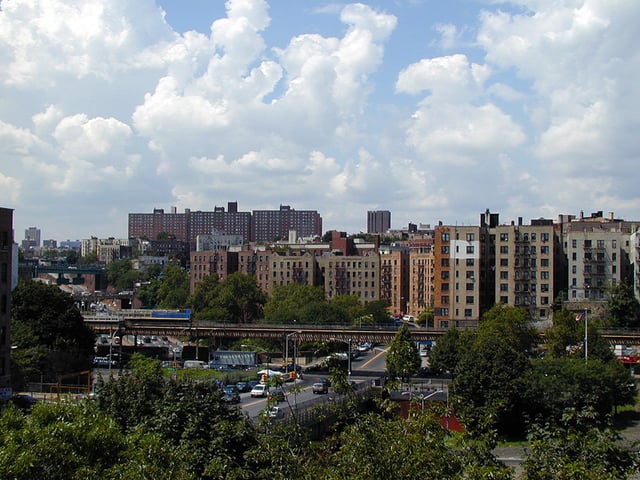
Morris Heights, a Bronx neighborhood of over 45,000
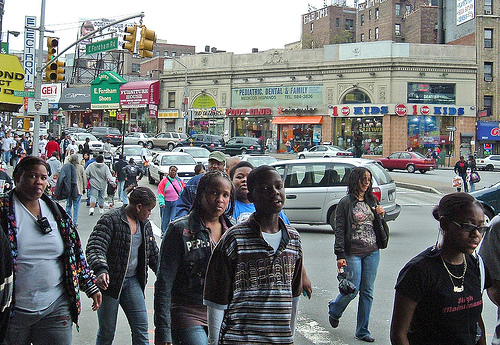
Street scene on Fordham Road, a major street in the Bronx
Prominent shopping areas in the Bronx include Fordham Road, Bay Plaza in Co-op City, The Hub, the Riverdale/Kingsbridge shopping center, and Bruckner Boulevard. Shops are also concentrated on streets aligned underneath elevated railroad lines, including Westchester Avenue, White Plains Road, Jerome Avenue, Southern Boulevard, and Broadway. The Gateway Center at Bronx Terminal Market contains several big-box stores, which opened in 2009 south of Yankee Stadium.
There are three primary shopping centers in the Bronx: The Hub, Gateway Center and Southern Boulevard. The Hub–Third Avenue Business Improvement District (B.I.D.), in The Hub, is the retail heart of the South Bronx, located where four roads converge: East 149th Street, Willis, Melrose and Third Avenues.[133] It is primarily located inside the neighborhood of Melrose but also lines the northern border of Mott Haven.[134] The Hub has been called "the Broadway of the Bronx", being likened to the real Broadway in Manhattan and the northwestern Bronx.[135] It is the site of both maximum traffic and architectural density. In configuration, it resembles a miniature Times Square, a spatial "bow-tie" created by the geometry of the street.[136] The Hub is part of Bronx Community Board 1.
The Gateway Center at Bronx Terminal Market, in the West Bronx, is a shopping center that encompasses less than one million square feet of retail space, built on a 17 acres (7 ha) site that formerly held the Bronx Terminal Market, a wholesale fruit and vegetable market as well as the former Bronx House of Detention, south of Yankee Stadium. The $500 million shopping center, which was completed in 2009, saw the construction of new buildings and two smaller buildings, one new and the other a renovation of an existing building that was part of the original market. The two main buildings are linked by a six-level garage for 2,600 cars. The center has earned itself a LEED "Silver" designation in its design.[137]
Education
Education in the Bronx is provided by a large number of public and private institutions, many of which draw students who live beyond the Bronx. The New York City Department of Education manages public noncharter schools in the borough. In 2000, public schools enrolled nearly 280,000 of the Bronx's residents over 3 years old (out of 333,100 enrolled in all pre-college schools).[138] There are also several public charter schools. Private schools range from élite independent schools to religiously affiliated schools run by the Roman Catholic Archdiocese of New York and Jewish organizations.
A small portion of land that is between Pelham and Pelham Bay Park, with a total of 35 houses, is a part of the Bronx, but is cut off from the rest of the borough due to the way the county boundaries were established; the New York City government pays for the residents' children to go to Pelham Union Free School District schools, including Pelham Memorial High School, since that is more cost effective than sending school buses to take the students to New York City schools. This arrangement has been in place since 1948.[139]
Educational attainment
In 2000, according to the U.S. Census, out of the nearly 800,000 people in the Bronx who were then at least 25 years old, 62.3% had graduated from high school and 14.6% held a bachelor's or higher college degree. These percentages were lower than those for New York's other boroughs, which ranged from 68.8% (Brooklyn) to 82.6% (Staten Island) for high school graduates over 24, and from 21.8% (Brooklyn) to 49.4% (Manhattan) for college graduates. (The respective state and national percentages were [NY] 79.1% & 27.4% and [US] 80.4% & 24.4%.)[140]
High schools

The Bronx High School of Science
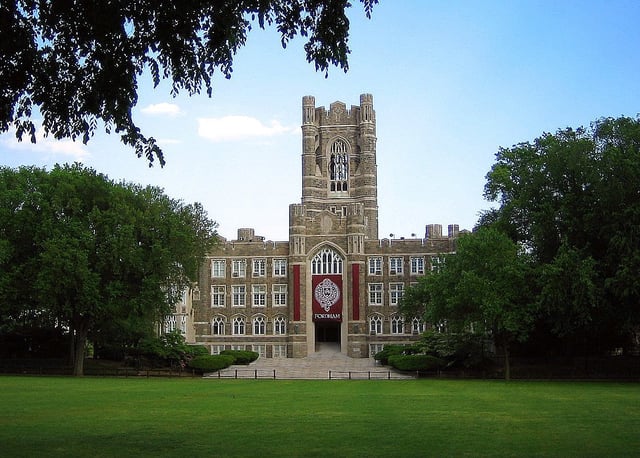
Fordham University's Keating Hall
In the 2000 Census, 79,240 of the nearly 95,000 Bronx residents enrolled in high school attended public schools.[138]
Many public high schools are located in the borough including the elite Bronx High School of Science, Celia Cruz Bronx High School of Music, DeWitt Clinton High School, High School for Violin and Dance, Bronx Leadership Academy 2, Bronx International High School, the School for Excellence, the Morris Academy for Collaborative Study, Wings Academy for young adults, The Bronx School for Law, Government and Justice, Validus Preparatory Academy, The Eagle Academy For Young Men, Bronx Expeditionary Learning High School, Bronx Academy of Letters, Herbert H. Lehman High School and High School of American Studies. The Bronx is also home to three of New York City's most prestigious private, secular schools: Fieldston, Horace Mann, and Riverdale Country School.
High schools linked to the Catholic Church include: Saint Raymond's Academy for Girls, All Hallows High School, Fordham Preparatory School, Monsignor Scanlan High School, St. Raymond High School for Boys, Cardinal Hayes High School, Cardinal Spellman High School, The Academy of Mount Saint Ursula, Aquinas High School, Preston High School, St. Catharine Academy, Mount Saint Michael Academy, and St. Barnabas High School.
The SAR Academy and SAR High School are Modern Orthodox Jewish Yeshiva coeducational day schools in Riverdale, with roots in Manhattan's Lower East Side.
In the 1990s, New York City began closing the large, public high schools in the Bronx and replacing them with small high schools. Among the reasons cited for the changes were poor graduation rates and concerns about safety. Schools that have been closed or reduced in size include John F. Kennedy, James Monroe, Taft, Theodore Roosevelt, Adlai Stevenson, Evander Childs, Christopher Columbus, Morris, Walton, and South Bronx High Schools. More recently the City has started phasing out large middle schools, also replacing them with smaller schools.
Colleges and universities
In 2000, 49,442 (57.5%) of the 86,014 Bronx residents seeking college, graduate or professional degrees attended public institutions.[138]
Several colleges and universities are located in the Bronx.
Fordham University was founded as St. John's College in 1841 by the Diocese of New York as the first Catholic institution of higher education in the northeast. It is now officially an independent institution, but strongly embraces its Jesuit heritage. The 85-acre (340,000 m2) Bronx campus, known as Rose Hill, is the main campus of the university, and is among the largest within the city (other Fordham campuses are located in Manhattan and Westchester County).[91]
Three campuses of the City University of New York are in the Bronx: Hostos Community College, Bronx Community College (occupying the former University Heights Campus of New York University)[141] and Herbert H. Lehman College (formerly the uptown campus of Hunter College), which offers both undergraduate and graduate degrees.
The College of Mount Saint Vincent is a Catholic liberal arts college in Riverdale under the direction of the Sisters of Charity of New York. Founded in 1847 as a school for girls, the academy became a degree-granting college in 1911 and began admitting men in 1974. The school serves 1,600 students. Its campus is also home to the Academy for Jewish Religion, a transdenominational rabbinical and cantorial school.
Manhattan College is a Catholic college in Riverdale which offers undergraduate programs in the arts, business, education, engineering, and science. It also offers graduate programs in education and engineering.
Albert Einstein College of Medicine, part of the Montefiore Medical Center, is in Morris Park.
Two colleges based in Westchester County have Bronx campuses. The Catholic and nearly all-female College of New Rochelle maintains satellite campuses at Co-op City and in The Hub. The coeducational and non-sectarian Mercy College in Dobbs Ferry, founded by the Catholic Sisters of Mercy in 1950, has a campus near Westchester Square.
By contrast, the private, proprietary Monroe College, focused on preparation for business and the professions, started in the Bronx in 1933 but now has a campus in New Rochelle (Westchester County) as well the Bronx's Fordham neighborhood.[142]
The State University of New York Maritime College in Fort Schuyler (Throggs Neck)—at the far southeastern tip of the Bronx—is the national leader in maritime education and houses the Maritime Industry Museum. (Directly across Long Island Sound is Kings Point, Long Island, home of the United States Merchant Marine Academy and the American Merchant Marine Museum.) As of 2017, graduates from the university earned an average annual salary of $144,000, the highest of any university graduates in the United States.[143]
Culture and institutions
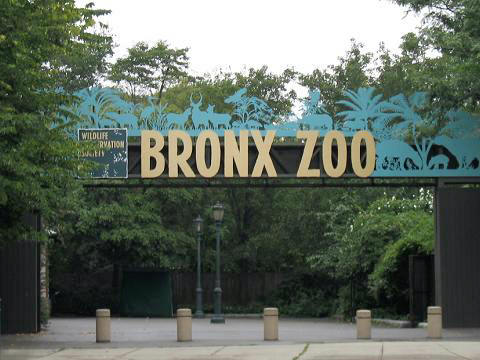
The Bronx Zoo is the largest zoo in New York City, and among the largest in the country.
Author Edgar Allan Poe spent the last years of his life (1846 to 1849) in the Bronx at Poe Cottage, now located at Kingsbridge Road and the Grand Concourse. A small wooden farmhouse built around 1812, the cottage once commanded unobstructed vistas over the rolling Bronx hills to the shores of Long Island.[146] Poe moved there to get away from the Manhattan city air and crowding in hope that the then rural area would be beneficial for his wife's tuberculosis. It was in the Bronx that Poe wrote one of his most famous works, Annabel Lee.[147]
More than a century later, the Bronx would evolve from a hot bed of Latin jazz to an incubator of hip hop as documented in the award-winning documentary, produced by City Lore and broadcast on PBS in 2006, "From Mambo to Hip Hop: A South Bronx Tale."[148] Hip Hop first emerged in the South Bronx in the early 1970s. The New York Times has identified 1520 Sedgwick Avenue "an otherwise unremarkable high-rise just north of the Cross Bronx Expressway and hard along the Major Deegan Expressway" as a starting point, where DJ Kool Herc presided over parties in the community room.[149][150] The 2016 Netflix series The Get Down is based on the development of hip hop in 1977 in the South Bronx.[151] Ten years earlier, the Bronx Opera had been founded.
Founding of hip-hop
On August 11, 1973, DJ Kool Herc was a D.J. and M.C. at a party in the recreation room of 1520 Sedgwick Avenue in the Bronx adjacent to the Cross Bronx Expressway.[152] While it was not the actual "Birthplace of Hip Hop" – the genre developed slowly in several places in the 1970s – it was verified to be the place where one of the pivotal and formative events occurred.[152] Specifically:
Beginning with the advent of beat match DJing, in which Bronx disc jockeys) including Grandmaster Flash, Afrika Bambaataa and DJ Kool Herc extended the breaks of funk records, a major new musical genre emerged that sought to isolate the percussion breaks of hit funk, disco and soul songs. As hip hop's popularity grew, performers began speaking ("rapping") in sync with the beats, and became known as MCs or emcees. The Herculoids, made up of Herc, Coke La Rock, and Clark Kent,[2] were the earliest to gain major fame. The Bronx is referred to in hip-hop slang as "The Boogie Down Bronx", or just "The Boogie Down". This was hip-hop pioneer KRS-One's inspiration for his group BDP, or Boogie Down Productions, which included DJ Scott La Rock. Newer hip hop artists from the Bronx include Big Pun, Lord Tariq and Peter Gunz, Camp Lo, Swizz Beatz, Drag-On, Fat Joe, Terror Squad and Cory Gunz.[153]
Hush Hip Hop Tours, a tour company founded in 2002 by local licensed sightseeing tour guide Debra Harris,[154] has established a sightseeing tour of the Bronx showcasing the locations that helped shape hip hop culture, and features some of the pioneers of hip hop as tour guides. The Bronx's recognition as an important center of African-American culture has led Fordham University to establish the Bronx African-American History Project (BAAHP).[155]
Sports
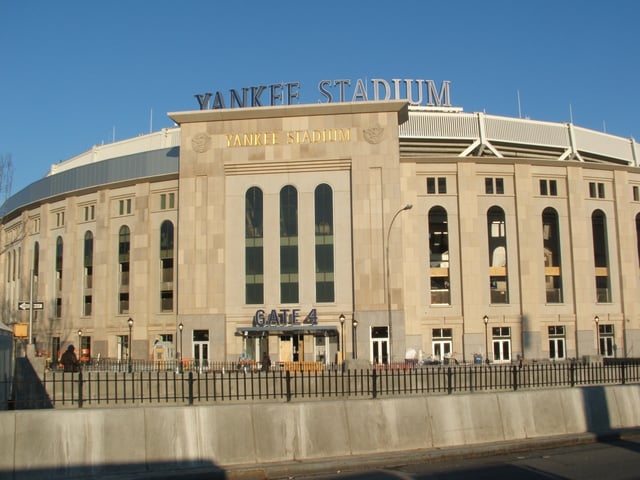
New Yankee Stadium at 161st and River Avenue
The Bronx is the home of the New York Yankees, nicknamed "the Bronx Bombers", of Major League Baseball. The original Yankee Stadium opened in 1923 on 161st Street and River Avenue, a year that saw the Yankees bring home their first of 27 World Series Championships. With the famous facade, the short right field porch and Monument Park, Yankee Stadium has been home to many of baseball's greatest players including Babe Ruth, Lou Gehrig, Joe DiMaggio, Whitey Ford, Yogi Berra, Mickey Mantle, Reggie Jackson, Thurman Munson, Don Mattingly, Derek Jeter and Mariano Rivera.
The original stadium was the scene of Lou Gehrig's Farewell Speech in 1939, Don Larsen's perfect game in the 1956 World Series, Roger Maris' record breaking 61st home run in 1961, and Reggie Jackson's 3 home runs to clinch Game 6 of the 1977 World Series. The Stadium was the former home of the New York Giants of the National Football League from 1956 to 1973.
The original Yankee Stadium closed in 2008 to make way for a new Yankee Stadium in which the team started play in 2009. It is located north-northeast of the 1923 Yankee Stadium, on the former site of Macombs Dam Park. The current Yankee Stadium is also the home of New York City FC of Major League Soccer, who began play in 2015.
Off-Off-Broadway
The Bronx is home to several Off-Off-Broadway theaters, many staging new works by immigrant playwrights from Latin America and Africa. The Pregones Theater, which produces Latin American work, opened a new 130-seat theater in 2005 on Walton Avenue in the South Bronx. Some artists from elsewhere in New York City have begun to converge on the area, and housing prices have nearly quadrupled in the area since 2002. However rising prices directly correlate to a housing shortage across the city and the entire metro area.
Arts
The Bronx Academy of Arts and Dance, founded in 1998 by Arthur Aviles and Charles Rice-Gonzalez, provides dance, theatre and art workshops, festivals and performances focusing on contemporary and modern art in relation to race, gender, and sexuality. It is home to the Arthur Aviles Typical Theatre, a contemporary dance company, and the Bronx Dance Coalition. The Academy was formerly in the American Bank Note Company Building before relocating to a venue on the grounds of St. Peter's Episcopal Church.[156]
The Bronx Museum of the Arts, founded in 1971, exhibits 20th century and contemporary art through its central museum space and 11,000 square feet (1,000 m2) of galleries. Many of its exhibitions are on themes of special interest to the Bronx. Its permanent collection features more than 800 works of art, primarily by artists from Africa, Asia and Latin America, including paintings, photographs, prints, drawings, and mixed media. The museum was temporarily closed in 2006 while it underwent a major expansion designed by the architectural firm Arquitectonica.
The Bronx has also become home to a peculiar poetic tribute in the form of the "Heinrich Heine Memorial", better known as the Lorelei Fountain. After Heine's German birthplace of Düsseldorf had rejected, allegedly for anti-Semitic motives, a centennial monument to the radical German-Jewish poet (1797–1856), his incensed German-American admirers, including Carl Schurz, started a movement to place one instead in Midtown Manhattan, at Fifth Avenue and 59th Street. However, this intention was thwarted by a combination of ethnic antagonism, aesthetic controversy and political struggles over the institutional control of public art.[157] In 1899, the memorial by Ernst Gustav Herter was placed in Joyce Kilmer Park, near the Yankee Stadium. In 1999, it was moved to 161st Street and the Concourse.
Maritime heritage
The peninsular borough's maritime heritage is acknowledged in several ways.The City Island Historical Society and Nautical Museum [242] occupies a former public school designed by the New York City school system's turn-of-the-last-century master architect C. B. J. Snyder. The state's Maritime College in Fort Schuyler (on the southeastern shore) houses the Maritime Industry Museum.[158] In addition, the Harlem River is reemerging as "Scullers' Row"[159] due in large part to the efforts of the Bronx River Restoration Project,[160] a joint public-private endeavor of the city's parks department. Canoeing and kayaking on the borough's namesake river have been promoted by the Bronx River Alliance [243] . The river is also straddled by the New York Botanical Gardens, its neighbor, the Bronx Zoo, and a little further south, on the west shore, Bronx River Art Center.[161]
Community celebrations
"Bronx Week," traditionally held in May, originated as a one-day celebration. Initiated by Bronx historian Lloyd Ultan and supported by then borough president Robert Abrams, the original one-day program was based on the "Bronx Borough Day" festival which took place in the 1920s. The following year, at the height of the decade's civil unrest, the festival was extended to a one-week event. In the 1980s the key event, the "Bronx Ball," was launched. The week includes the Bronx Week Parade as well as inductions into the "Bronx Walk of Fame."[162]
Various Bronx neighborhoods conduct their own community celebrations. The Arthur Avenue "Little Italy" neighborhood conducts an annual Autumn Ferragosto Festival that celebrates Italian culture.[163] Hunts Point hosts an annual "Fish Parade and Summer Festival" at the start of summer.[164] Edgewater Park hosts an annual "Ragamuffin" children's walk in November.[165] There are several events to honor the borough's veterans.[166] Albanian Independence Day is also observed.[167]
Press and broadcasting
The Bronx is home to several local newspapers and radio and television studios.
Newspapers
The Bronx has several local newspapers, including The Bronx News,[171] Parkchester News, City News, The Norwood News, The Riverdale Press, Riverdale Review, The Bronx Times Reporter, Inner City Press[172] (which now has more of a focus on national issues) and Co-op City Times. Four non-profit news outlets, Norwood News, Mount Hope Monitor, Mott Haven Herald and The Hunts Point Express serve the borough's poorer communities. The editor and co-publisher of The Riverdale Press, Bernard Stein, won the Pulitzer Prize for Editorial Writing for his editorials about Bronx and New York City issues in 1998. (Stein graduated from the Bronx High School of Science in 1959.)
The Bronx once had its own daily newspaper, The Bronx Home News, which started publishing on January 20, 1907, and merged into the New York Post in 1948. It became a special section of the Post, sold only in the Bronx, and eventually disappeared from view.
Radio and television
One of New York City's major non-commercial radio broadcasters is WFUV, a National Public Radio-affiliated 50,000-watt station broadcasting from Fordham University's Rose Hill campus in the Bronx. The radio station's antenna is atop an apartment building owned by Montefiore Medical Center.
The City of New York has an official television station run by NYC Media and broadcasting from Bronx Community College, and Cablevision operates News 12 The Bronx, both of which feature programming based in the Bronx. Co-op City was the first area in the Bronx, and the first in New York beyond Manhattan, to have its own cable television provider. The local public-access television station BronxNet originates from Herbert H. Lehman College, the borough's only four year CUNY school, and provides government-access television (GATV) public affairs programming in addition to programming produced by Bronx residents.[173]
Gangs
The Bronx is the home of many gangs, including:
Dominicans Don't Play - formed around 1990, it primarily targets high school students and second-generation immigrants to join their gang, and make most of their money from robberies and drug deals.[174]
Trinitarios - also formed around 1990, a spin-off of Dominicans Don't Play, mostly involved with drug, sex, and weapons trafficking[175][176]
Latin Kings - a nationwide gang whose Bronx chapter began in 1986, involved with gun and drug trafficking, extortion, credit card fraud, and auto theft as their sources of income[174]
Ñetas - a gang that was started in 1979 in Puerto Rico. The organization began as a prison gang which gave members protection while serving their prison sentences. It eventually transformed into a drug trafficking gang.[174]
St. James Boys[177]
194 Crew - a drug trafficking gang[178]
Sureños - made up of first- and second-generation Mexican-Americans, mainly involved in small-scale crime and gang warfare[179]
In popular culture
Film and television
Mid-20th century
Mid-20th century movies set in the Bronx portrayed densely settled, working-class, urban culture. Hollywood films such as From This Day Forward (1946), set in Highbridge, occasionally delved into Bronx life. Paddy Chayefsky's Academy Award-winning Marty was the most notable examination of working class Bronx life[180] was also explored by Chayefsky in his 1956 film The Catered Affair, and in the 1993 Robert De Niro/Chazz Palminteri film, A Bronx Tale, Spike Lee's 1999 movie Summer of Sam, centered in an Italian-American Bronx community, 1994's I Like It Like That that takes place in the predominantly Puerto Rican neighborhood of the South Bronx, and Doughboys, the story of two Italian-American brothers in danger of losing their bakery thanks to one brother's gambling debts.
The Bronx's gritty urban life had worked its way into the movies even earlier, with depictions of the "Bronx cheer", a loud flatulent-like sound of disapproval, allegedly first made by New York Yankees fans. The sound can be heard, for example, on the Spike Jones and His City Slickers recording of "Der Fuehrer's Face" (from the 1942 Disney animated film of the same name), repeatedly lambasting Adolf Hitler with: "We'll Heil! (Bronx cheer) Heil! (Bronx cheer) Right in Der Fuehrer's Face!"[181]
As a symbolism
Some movies have also used the term Bronx for comic effect, such as "Bronx", the character on the Disney animated series Gargoyles.
Starting in the 1970s, the Bronx often symbolized violence, decay, and urban ruin. The wave of arson in the South Bronx in the 1960s and 1970s inspired the observation that "The Bronx is burning": in 1974 it was the title of both a The New York Times editorial and a BBC documentary film. The line entered the pop-consciousness with Game Two of the 1977 World Series, when a fire broke out near Yankee Stadium as the team was playing the Los Angeles Dodgers. Numerous fires had previously broken out in the Bronx prior to this fire. As the fire was captured on live television, announcer Howard Cosell is wrongly remembered to have said something like, "There it is, ladies and gentlemen: the Bronx is burning". Historians of New York City frequently point to Cosell's remark as an acknowledgement of both the city and the borough's decline.[182] A new feature-length documentary film by Edwin Pagan called Bronx Burning[183] is in production[184] in 2006, chronicling what led up to the numerous arson-for-insurance fraud fires of the 1970s in the borough.
Bronx gang life was depicted in the 1974 novel The Wanderers by Bronx native Richard Price and the 1979 movie of the same name. They are set in the heart of the Bronx, showing apartment life and the then-landmark Krums ice cream parlor. In the 1979 film The Warriors, the eponymous gang go to a meeting in Van Cortlandt Park in the Bronx, and have to fight their way out of the borough and get back to Coney Island in Brooklyn. A Bronx Tale (1993) depicts gang activities in the Belmont "Little Italy" section of the Bronx. The 2005 video game adaptation features levels called Pelham, Tremont, and "Gunhill" (a play off the name Gun Hill Road). This theme lends itself to the title of The Bronx Is Burning, an eight-part ESPN TV mini-series (2007) about the New York Yankees' drive to winning baseball's 1977 World Series. The TV series emphasizes the boisterous nature of the team, led by manager Billy Martin, catcher Thurman Munson and outfielder Reggie Jackson, as well as the malaise of the Bronx and New York City in general during that time, such as the blackout, the city's serious financial woes and near bankruptcy, the arson for insurance payments, and the election of Ed Koch as mayor.
The 1981 film Fort Apache, The Bronx is another film that used the Bronx's gritty image for its storyline. The movie's title is from the nickname for the 41st Police Precinct in the South Bronx which was nicknamed "Fort Apache". Also from 1981 is the horror film Wolfen making use of the rubble of the Bronx as a home for werewolf type creatures. Knights of the South Bronx, a true story of a teacher who worked with disadvantaged children, is another film also set in the Bronx released in 2005. The Bronx was the setting for the 1983 film Fuga dal Bronx, also known as Bronx Warriors 2 and Escape 2000, an Italian B-movie best known for its appearance on the television series Mystery Science Theater 3000. The plot revolves around a sinister construction corporation's plans to depopulate, destroy and redevelop the Bronx, and a band of rebels who are out to expose the corporation's murderous ways and save their homes. The film is memorable for its almost incessant use of the phrase, "Leave the Bronx!" Many of the movie's scenes were filmed in Queens, substituting as the Bronx. Rumble in the Bronx, filmed in Vancouver, was a 1995 Jackie Chan kung-fu film, another which popularized the Bronx to international audiences. Last Bronx, a 1996 Sega game played on the bad reputation of the Bronx to lend its name to an alternate version of post-Japanese bubble Tokyo, where crime and gang warfare is rampant.
As a setting
Bronx native Nancy Savoca's 1989 comedy, True Love, explores two Italian-American Bronx sweethearts in the days before their wedding. The film, which debuted Annabella Sciorra and Ron Eldard as the betrothed couple, won the Grand Jury Prize at that year's Sundance Film Festival. The CBS television sitcom Becker, 1998–2004, was more ambiguous. The show starred Ted Danson as Dr. John Becker, a doctor who operated a small practice and was constantly annoyed by his patients, co-workers, friends, and practically everything and everybody else in his world. It showed his everyday life as a doctor working in a small clinic in the Bronx.
Penny Marshall's 1990 film Awakenings, which was nominated for several Oscars, is based on neurologist Oliver Sacks' 1973 account of his psychiatric patients at Beth Abraham Hospital in the Bronx who were paralyzed by a form of encephalitis but briefly responded to the drug L-dopa. Robin Williams played the physician; Robert De Niro was one of the patients who emerged from a catatonic (frozen) state. The home of Williams' character was shot not far from Sacks' actual City Island residence. A 1973 Yorkshire Television documentary [244] and "A Kind of Alaska", a 1985 play by Harold Pinter,[185] were also based on Sacks' book.
Gus Van Sant's 2000 Finding Forrester was quickly billed "Good Will Hunting in the Hood." Sean Connery is in the title role of a reclusive old man who 50 years earlier wrote a single novel that garnered the Pulitzer Prize. He meets 16-year-old Jamal, portrayed by Rob Brown, a gifted basketball player and aspiring writer from the Bronx, and becomes his mentor. The movie includes stock footage of Bronx housing projects from 1990, as well as some other scenes shot in Manhattan and Brooklyn.
The 2012 documentary "South Bronx United" features the Mott Haven neighborhood and its conflict over the online grocery delivery service Fresh Direct's move of their trucking facility from Long Island City to the South Bronx.
In literature
Books
The Bronx has been featured significantly in fiction literature. All of the characters in Herman Wouk's City Boy: The Adventures of Herbie Bookbinder (1948) live in the Bronx, and about half of the action is set there. Kate Simon's Bronx Primitive: Portraits of a Childhood is directly autobiographical, a warm account of a Polish-Jewish girl in an immigrant family growing up before World War II, and living near Arthur Avenue and Tremont Avenue.[186] In Jacob M. Appel's short story, "The Grand Concourse" (2007),[187] a woman who grew up in the iconic Lewis Morris Building returns to the Morrisania neighborhood with her adult daughter. Similarly, in Avery Corman's book The Old Neighborhood (1980),[188] an upper-middle class white protagonist returns to his birth neighborhood (Fordham Road and the Grand Concourse), and learns that even though the folks are poor, Hispanic and African-American, they are good people.
By contrast, Tom Wolfe's Bonfire of the Vanities (1987)[189] portrays a wealthy, white protagonist, Sherman McCoy, getting lost off the Bruckner Expressway in the South Bronx and having an altercation with locals. A substantial piece of the last part of the book is set in the resulting riotous trial at the Bronx County Courthouse. However, times change, and in 2007, The New York Times reported that "the Bronx neighborhoods near the site of Sherman's accident are now dotted with townhouses and apartments." In the same article, the Reverend Al Sharpton (whose fictional analogue in the novel is "Reverend Bacon") asserts that "twenty years later, the cynicism of The Bonfire of the Vanities is as out of style as Tom Wolfe's wardrobe."[190]
Don DeLillo's Underworld (1997) is also set in the Bronx and offers a perspective on the decline of the area from the 1950s onwards. John Patrick Shanley's "Savage in Limbo" is set in a 1980s Bronx bar called 'Scales' where the frustrated characters feel they are unable to move.
Poetry
In poetry, the Bronx has been immortalized by one of the world's shortest couplets:
Nash repented 33 years after his calumny, penning in 1964 the following prose poem to the Dean of Bronx Community College:
In 2016, W. R. Rodriguez published Bronx Trilogy—consisting of the shoe shine parlor poems et al, concrete pastures of the beautiful bronx, and from the banks of brook avenue. The trilogy celebrates Bronx people, places, and events. DeWitt Clinton High School, St. Mary's Park, and Brook Avenue are a few of the schools, parks, and streets Rodriguez uses as subjects for his poems.[191]
Nash's couplet "The Bronx No Thonx" and his subsequent blessing are mentioned in Bronx Accent: A Literary and Pictorial History of the Borough, edited by Llyod Ultan and Barbara Unger and published in 2000. The book, which includes the work of Yiddish poets, offers a selection from Allen Ginsberg's Kaddish, as his Aunt Elanor and his mother, Naomi, lived near Woodlawn Cemetery. Also featured is Ruth Lisa Schecther's poem, "Bronx", which is described as a celebration of the borough's landmarks. There is a selection of works from poets such as Sandra María Esteves, Milton Kessler, Joan Murray, W. R. Rodriguez, Myra Shapiro, Gayl Teller, and Terence Wynch.[192]
Bronx Memoir Project
Bronx Memoir Project: Vol. 1 is a published anthology by the Bronx Council on the Arts and brought forth through a series of workshops meant to empower Bronx residents and shed the stigma on the Bronx's burning past.[195] The Bronx Memoir Project was created as an ongoing collaboration between the Bronx Council on the Arts and other cultural institutions, including The Bronx Documentary Center, The Bronx Library Center, the (Edgar Allan) Poe Park Visitor Center, Mindbuilders, and other institutions and funded through a grant from the National Endowment for the Arts.[196][197] The goal was to develop and refine memoir fragments written by people of all walks of life that share a common bond residing within the Bronx.[196]
In songs
The theme song to the 1960s U.S. television comedy series Car 54, Where Are You? begins "There's a holdup in the Bronx".
The song "New York, New York" from the 1944 musical comedy and 1949 film, On the Town explains that "The Bronx is up and the Battery's down."
"Manhattan" by Rodgers and Hart for the 1925 musical The Garrick Gaieties declares "We'll have Manhattan,/The Bronx and Staten/Island too./It's lovely going through/the zoo."
In Marc Ferris's 5-page, 15-column list of "Songs and Compositions Inspired by New York City" in The Encyclopedia of New York City (1995),[198] only a handful refer to the Bronx; most refer to New York City proper, especially Manhattan and Brooklyn. Ferris's extensive but selective 1995 list mentions only four songs referring specifically to the Bronx: "On the Banks of the Bronx" (1919), William LeBaron, Victor Jacobi; "Bronx Express" (1922), Henry Creamer and Henry Creamer; "The Tremont Avenue Cruisewear Fashion Show" (1973), Jerry Livingston, Mark David; "I Love the New York Yankees" (1987), Paula Lindstrom.
The following songs also mention the Bronx (see also list of songs about New York City):
"Bronx Season" by Cardi B on her 2017 album Gangsta Bitch Music, Vol. 2
"Alfie from the Bronx" (1983) by the Toy Dolls
"Back to the Bronx" by 2 Live Crew
"Boogie Down Bronx" by Man Parrish[199]
"Bronx" by Kurtis Blow
"The Bronx" by Regina Spektor
"Bronx Backyard" by The Johnny Seven Band
"Bronx Bombers" by Grandmaster Flash
"The Bronx Is Beautiful" by Robert Klein
"Bronx Keeps Creating It" by Fat Joe
"Bronx Tale" by Fat Joe
"Bronx War Stories" by A.I.G.
"BX Warrior" by Tim Dog
"BX We Invented Hip-Hop" by Tim Dog
"Cousin in the Bronx" by Kaiser Chiefs
"Cross Bronx Expressway" by Lord Tariq and Peter Gunz
"Deja Vu (Uptown Baby)" by Lord Tariq & Peter Gunz
"From BX" by Tim Dog
"Ha Ya Doin? Yankees" – The Haya Doin'? Boys
"Here Come the Yankees", by Bob Bundin and Lou Stallman
"Jenny from the Block" by Jennifer Lopez featuring Styles P & Jadakiss
"On The Streets Of the Bronx" by The Moonglows
"Our Lady of the Bronx" by Black 47
"Rockin' the Bronx" by Black 47
"School of Hard Knocks" by Swizz Beatz and Drag-On
"South Bronx" by Boogie Down Productions
"Lost in the Flood" by Bruce Springsteen
"Bulls In the Bronx" by Pierce the Veil
See also
Bronx Borough Hall
Bronx court system delays
Joseph P. Day, early land auctioneer
List of people from the Bronx
National Register of Historic Places listings in the Bronx
General:
List of counties in New York
References
- "Jonas Bronx". Bronx Notables. Bronx Historical Society. Archived from the original on May 9, 2008. Retrieved January 20, 2012. van Laer, A. J. F. (October 1916). "Scandinavian Immigrants in New York, 1630–1674". The American Historical Review. Chicago: The University of Chicago Press on behalf of the American Historical Association. 22 (1): 164–166. doi:10.1086/ahr/22.1.164. JSTOR 1836219. "... Jonas Bronck was a Dane ...". Burrows, Edwin G.; Wallace, Mike (Michael L.) (1999). Gotham, A History of New York City to 1898. 1. Oxford, New York: Oxford University Press. pp. 30–37. ISBN 0-19-511634-8. ... many of these colonists, perhaps as many as half of them, represented the same broad mixture of nationalities as New Amsterdam itself. Among them were Swedes, Germans, French, Belgians, Africans, and Danes (such as a certain Jonas Bronck)...

![The Bronx's P.L.A.Y.E.R.S. Club Steppers performing at the 2007 Fort Greene Park Summer Literary Festival in Brooklyn. (Note the T-shirts' inscription "I ♥ BX" [Bronx], echoing the ubiquitous slogan "I ♥ NY" [I Love New York] ).](https://everipedia.org/cdn-cgi/image/width=640/https://upload.wikimedia.org/wikipedia/commons/a/a8/The_PLAYERS_Club_Steppers_by_David_Shankbone.jpg)